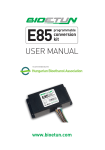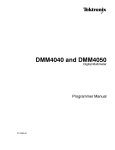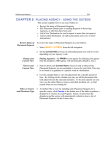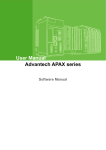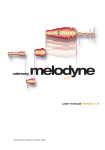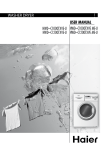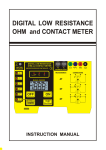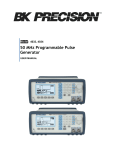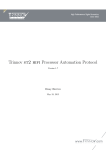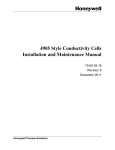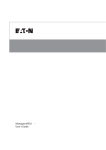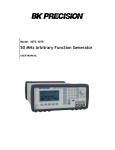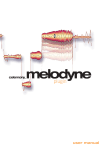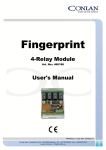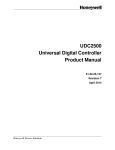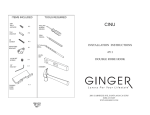Download Programming Manual
Transcript
DC Electronic Load
PEL-3000
PROGRAMMING MANUAL
VERSION: 1.11
ISO-9001 CERTIFIED MANUFACTURER
This manual contains proprietary information, which is protected by
copyright. All rights are reserved. No part of this manual may be
photocopied, reproduced or translated to another language without
prior written consent of Good Will company.
The information in this manual was correct at the time of printing.
However, Good Will continues to improve products and reserves the
rights to change specification, equipment, and maintenance
procedures at any time without notice.
Good Will Instrument Co., Ltd.
No. 7-1, Jhongsing Rd., Tucheng Dist., New Taipei City 236, Taiwan.
Table of Contents
Table of Contents
INTERFACE OVERVIEW ..................................................... 2
Front Panel Overview ............................. 3
Rear Panel Overview .............................. 4
Interface Configuration .......................... 5
COMMNAND OVERVIEW ................................................ 16
Command Syntax ................................. 16
Command List ..................................... 21
Error Messages .................................... 90
1
PEL-3000 Programming Manual
INTERFACE OVERVIEW
This chapter describes basic configuration of
IEEE488.2 based remote control.
Front Panel Overview ........................................................ 3
Rear Panel Overview .......................................................... 4
Interface Configuration ..................................................... 5
Configure to USB Remote Interface ....................................................................... 5
Configure GPIB Interface ........................................................................................ 6
Configure RS232C ..................................................................................................... 7
RS232C/USB Remote Control Function Check ................................................... 8
Using Realterm to Establish a Remote Connection.............................................. 9
GPIB Function Check ............................................................................................ 13
2
INTERFACE OVERVIEW
Front Panel Overview
(PEL-3021/PEL-3041 shown)
Air inlet
LCD Display
Function keys
Power key
Main/Local
Local
FUNC/File
Main
File
FUNC
Utility
Help
Help/Utility
Short
Preset
Shift
175W
1.5 - 150V
0 - 35A
P7
P8
P9
7
8
9
P4
P5
P6
4
5
6
P1
P2
P3
1
2
P0
CAL.
0
I MON OUT
Load On/
Off
Load On/Off
3
Lock
Clear
Short
Enter
TRIG OUT
Scroll wheel
Input
terminals
I MON OUT,
TRIG OUT
USB Port, Preset
and Shift keys
Number pad, Clear/
Lock and Enter keys
3
PEL-3000 Programming Manual
Rear Panel Overview
(PEL-3021 / PEL-3041 shown)
Frame control ports,
J1, J2
Remote sense
inputs
Rear panel
inputs
FRAME CONT
SER. NO. LB
J1
J2
WARNING
TO AVOID ELECTRIC SHOCK THE POWER CORD
PROTECTIVE GROUNDING CONDUCTOR MUST BE
CONNECTED TO GROUND.
RS232C
NO OPERATOR SERVICEABLE COMPONENTS INSIDE.
RS232C port
DO NOT REMOVE COVERS.
REFER SERVICING TO QUALIFIED PERSONNEL.
GPIB
AC
100 - 120 VAC
200 - 240 VAC
47 - 63 Hz
90 VA MAX.
USB port
USB device port
GPIB
4
Power socket
and switch
Exhaust fan
INTERFACE OVERVIEW
Interface Configuration
Configure to USB Remote Interface
USB
configuration
Note
Operation
PC side
connector
Type A, host
PEL-3000 side
connector
Rear panel Type B, slave
Speed
2.0 (full speed)
USB Class
USB CDC AMC
Before USB can be used for remote control, it is
necessary to install the PEL-3000 USB device
driver, located on the accompanying User Manual
CD.
1. Connect the USB cable to the rear panel USB B
port.
Utility
2. Press Shift
+
> Interface[F3] and set
the Interface setting to USB.
Help
5
PEL-3000 Programming Manual
Configure GPIB Interface
To use GPIB, the optional GPIB port must be installed. See the user
manual for details.
Operation
1. Ensure the PEL-3000 is off before proceeding.
2. Connect a GPIB cable from a GPIB controller to
the GPIB port on the PEL-3000.
3. Turn the PEL-3000 on.
Utility
4. Press Shift
+ Help > Interface[F3] and set
the Interface setting to GPIB.
5. Set the GPIB address.
GPIB address
0~30
GPIB constraints Maximum 15 devices altogether, 20m cable length,
2m between each device
Unique address assigned to each device
At least 2/3 of the devices turned On
No loop or parallel connection
Pin Assignment
12
1
24
13
Pin
1~4
5
6
7
8
9
10
6
Signal
Data I/O 1~4
EOI
DAV
NRFD
NDAC
IFC
SRQ
Pin
13~16
17
18
19
20
21
22
Signal
Data I/O 5~8
REN
Ground (DAV)
Ground (NRFD)
Ground (NDAC)
Ground (IFC)
Ground (SRQ)
INTERFACE OVERVIEW
11
12
ATN
SHIELD Ground
23
24
Ground (ATN)
Single GND
Configure RS232C
RS232C
Configuration
Operation
Connector
DB-9, Male
Baud Rate
2400, 4800, 9600, 19200, 38400
Stop Bit
1, 2
Parity
None, Odd, Even
1. Connect an RS232C cable from the PC to the
rear panel RS232 port.
Utility
2. Press
+
> Interface[F3] and
set the Interface setting to RS232.
Shift
Help
3. Set the Baud Rate, Stop Bit and Parity settings.
Pin Assignment
12345
2: RxD (Receive data)
3: TxD (Transmit data)
6789
PC Connection
5: GND
4, 6 ~ 9: No connection
Use a null modem connection as shown in the
diagram below.
PEL-3000
PC
Pin2 RxD
RxD Pin2
Pin3 TxD
TxD Pin3
Pin5 GND
GND Pin5
7
PEL-3000 Programming Manual
RS232C/USB Remote Control Function Check
Functionality
check
Invoke a terminal application such as
RealTerm. For RS232C, set the COM port, baud
rate, stop bit, data bit and parity accordingly.
To check the COM settings, see the Device
Manager in the PC. For WinXP; Control panel
→ System → Hardware tab.
Run this query command via the terminal after
the instrument has been configured for
RS232/USB remote control (page 5).
*idn?
This should return the Manufacturer, Model
number, Serial number, and Firmware version
in the following format.
GW-INSTEK,PEL-3000, XXXXXXXXXXXX,
V.X.X.X.X
Manufacturer: GW-INSTEK
Model number : PEL-3000
Serial number : XXXXXXXXXXXX
Firmware version : V.X.X.X
8
INTERFACE OVERVIEW
Using Realterm to Establish a Remote Connection
Background
Realterm is a terminal program that can used to
communicate with a device attached to the
serial port of a PC or via an emulated serial port
via USB.
The following instructions apply to version
1.99.0.27. Even though Realterm is used as an
example to establish a remote connection, any
terminal program can be used that has similar
functionality.
Note
Realterm can be downloaded on Sourceforge.net
free of charge.
For more information please see
http://realterm.sourceforge.net/
Operation
1. Download Realterm and install according to the
instructions on the Realterm website.
2. Connect the PEL-3000 via USB (page 5) or via
RS232 (page 7).
3. If using RS232, make note of the configured
baud rate, stop bits and parity.
4. Go to the Windows device manager and find
the COM port number for the connection.
For example, go to the Start menu > Control
Panel > Device Manager
Double click the Ports icon to reveal the
connected serial port devices and the COM port
for the each connected device.
9
PEL-3000 Programming Manual
If using USB, the baud rate, stop bit and parity
settings can be viewed by right-clicking the
connected device and selecting the Properties
option.
5. Start Realterm on the PC as an administrator.
Click:
Start menu>All Programs>RealTerm>realterm
Tip: to run as an administrator, you can right
click the Realterm icon in the Windows Start
menu and select the Run as Administrator
option.
10
INTERFACE OVERVIEW
6. After Realterm has started, click on the Port tab.
Enter the Baud, Parity, Data bits, Stop bits and
Port number configuration for the connection.
The Hardware Flow Control, Software Flow
Control options can be left at the default
settings.
Press Open to connect to the PEL-3000.
11
PEL-3000 Programming Manual
7. Click on the Send tab.
In the EOL configuration, check on the +CR and
+LF check boxes.
Enter the query:
*idn?
Click on Send ASCII.
8. The terminal display will return the following:
GW, PEL-3XXX,EXXXXXXX,VX.XX.XXX
(manufacturer, model, serial number, version)
9. If Realterm fails to connect to the PEL-3000,
please check all the cables and settings and try
again.
12
INTERFACE OVERVIEW
GPIB Function Check
Functionality
check
Please use the National Instruments
Measurement & Automation Controller
software to confirm GPIB/LAN functionality.
See the National Instrument website,
http://www.ni.com for details.
Operation
1. Start the NI Measurement and
Automation Explorer (MAX)
program. Using Windows, press:
Start>All Programs>National
Instruments>Measurement & Automation
2. From the Configuration panel access;
My System>Devices and Interfaces>GPIB0
13
PEL-3000 Programming Manual
3. Press the Scan for Instruments button.
4. In the Connected Instruments panel the PEL-3000
should be detected as Instrument 0 with the
address the same as that configured on the
PEL-3000.
5. Double click the Instrument 0 icon.
3
2
4
5
6. Click on Communicate with Instrument.
7. In the NI-488.2 Communicator window, ensure
*IND? is written in the Send String: text box.
Click on the Query button to send the *IDN?
query to the instrument.
8. The String Received text box will display the
query return:
GW, PEL-3XXX,EXXXXXXX,VX.XX.XXX
(manufacturer, model, serial number, version)
14
INTERFACE OVERVIEW
6
7
8
9. The function check is complete.
15
PEL-3000 Programming Manual
COMMNAND OVERVIEW
The Command overview chapter lists all PEL-3000 commands in
functional order as well as alphabetical order. The command syntax
section shows you the basic syntax rules you have to apply when
using commands.
Command Syntax
Compatible
Standard
IEEE488.2
Partial compatibility
SCPI, 1999
Partial compatibility
Command
Structure
SCPI (Standard Commands for Programmable
Instruments) commands follow a tree-like
structure, organized into nodes. Each level of
the command tree is a node. Each keyword in a
SCPI command represents each node in the
command tree. Each keyword (node) of a SCPI
command is separated by a colon (:).
For example, the diagram below shows an SCPI
sub-structure and a command example.
[:MODE]:CRANGe
:MODE
:CRANGe
16
:VRANGe
:RESPonse
COMMNAND OVERVIEW
Command types
There are a number of different instrument
commands and queries. A command sends
instructions or data to the unit and a query
receives data or status information from the
unit.
Command types
Simple
A single command
with/without a parameter
Example
:CONFigure:RESPonse MAX
Query
A query is a simple or
compound command
followed by a question mark
(?). A parameter (data) is
returned.
Example
:CONFigure:RESPonse?
Compound
Two or more commands on
the same command line.
Compound commands are
separated with either a semicolon (;) or a semi-colon and a
colon (;:).
A semi-colon is used to join
two related commands, with
the caveat that the last
command must begin at the
last node of the first
command.
A semi-colon and colon are
used to combine two
commands from different
17
PEL-3000 Programming Manual
nodes.
Example
Command Forms
CONFigure:VON
MAX;:CONFigure:VDELay
MIN
Commands and queries have two different
forms, long and short. The command syntax is
written with the short form of the command in
capitals and the remainder (long form) in lower
case.
The commands can be written in capitals or
lower-case, just so long as the short or long
forms are complete. An incomplete command
will not be recognized.
Below are examples of correctly written
commands.
Long
:CURRent:LEVel?
form
:CURRENT:LEVEL?
:current:level?
Short
:CURR:LEV?
form
:curr:lev?
Square Brackets
Commands that contain square brackets
indicate that the contents are optional. The
function of the command is the same with or
without the square bracketed items, as shown
below
For example for the query:
“[:CONFigure]:GNG [:PASS]?”
Both “:CONFigure:GNG:PASS?” and “:GNG?”
are both valid forms.
18
COMMNAND OVERVIEW
Command
Format
:CURRent:Set
1
1.
2.
Common
Input Parameters
1.00A
2 3
Command header
Space
4
3.
4.
Parameter 1
Unit or suffix.
Type
Description
Example
<Boolean>
boolean logic
0, 1
<NR1>
integers
0, 1, 2, 3
<NR2>
decimal
numbers
0.1, 3.14, 8.5
<NR3>
floating point
4.5e-1, 8.25e+1
<NRf>
any of NR1, 2, 3 1, 1.5, 4.5e-1
[MIN]
(Optional
parameter)
For commands, this will set the
setting to the lowest value. This
parameter can be used in place of
any numerical parameter where
indicated.
For queries, it will return the
lowest possible value allowed for
the particular setting.
[MAX]
(Optional
parameter)
For commands, this will set the
setting to the highest value. This
parameter can be used in place of
any numerical parameter where
indicated.
For queries, it will return the
highest possible value allowed
for the particular setting.
Unit Suffixes Unit suffixes can be optionally
(Optional
used with most NRf type input
parameters) parameters.
19
PEL-3000 Programming Manual
Message
Terminator
20
[A]
Amps
1.00A
[%]
Percentage
10%
[V]
Volts
5.00V
[W]
Watts
3.00W
[mS]
milliseconds
20mS
[mV]
Millivolts
150mV
[S]
Seconds
5S
[MHO]
Reciprocal of
one ohm
0. 02MHO
[mA/uS]
Millamps/
microsecond
100mA/uS
[Hz]
Hertz
1000Hz
LF
Line feed code (0x0A)
COMMNAND OVERVIEW
Command List
Common
Commands
*CLS ....................................................................................... 25
*ESE ....................................................................................... 25
*ESR? ..................................................................................... 26
*IDN?..................................................................................... 26
*OPC ...................................................................................... 27
*RCL....................................................................................... 27
*RST ....................................................................................... 27
*SAV....................................................................................... 28
*SRE ....................................................................................... 28
*STB? ..................................................................................... 29
*TRG ...................................................................................... 29
*TST? ..................................................................................... 30
Trigger
Commands
:ABORt .................................................................................. 30
:INPut..................................................................................... 30
:INPut:SHORt ...................................................................... 31
Measurement
Commands
:MEASure:CURRent? .......................................................... 32
:MEASure:VOLTage? .......................................................... 32
:MEASure:POWer? .............................................................. 32
:MEASure:ETIMe? ............................................................... 33
Configure
Subsystem
Commands
[:CONFigure]:OCP .............................................................. 34
[:CONFigure]:OPP ............................................................... 35
[:CONFigure]:UVP............................................................... 36
[:CONFigure]:OVP .............................................................. 36
[:CONFigure]:SSTart............................................................ 37
[:CONFigure]:VON ............................................................. 38
[:CONFigure]:VDELay........................................................ 38
:CONFigure:RESPonse ....................................................... 39
[:CONFigure]:CNTime ........................................................ 40
[:CONFigure]:COTime ........................................................ 40
[:CONFigure]:CRUnit .......................................................... 41
:CONFigure:DYNamic........................................................ 41
:CONFigure:MEMory.......................................................... 42
:CONFigure:SHORt............................................................. 43
21
PEL-3000 Programming Manual
[:CONFigure]:GNG:SPECtest ........................................... 43
[:CONFigure]:GNG:DTIMe .............................................. 44
[:CONFigure]:GNG:MODE .............................................. 44
[:CONFigure]:GNG[:PASS]................................................ 45
[:CONFigure]:GNG:H ........................................................ 45
[:CONFigure]:GNG:L ......................................................... 46
[:CONFigure]:GNG:C ......................................................... 46
Parallel
Commands
[:CONFigure]:PARallel ........................................................ 47
Step Commands [:CONFigure]:STEP:CCH ................................................... 48
[:CONFigure]:STEP:CCM .................................................. 49
[:CONFigure]:STEP:CCL.................................................... 50
[:CONFigure]:STEP:CC ...................................................... 50
[:CONFigure]:STEP:CRH ................................................... 51
[:CONFigure]:STEP:CRM .................................................. 51
[:CONFigure]:STEP:CRL.................................................... 52
[:CONFigure]:STEP:CR ...................................................... 52
[:CONFigure]:STEP:CVH................................................... 53
[:CONFigure]:STEP:CVL ................................................... 53
[:CONFigure]:STEP:CV ...................................................... 54
[:CONFigure]:STEP:CPH ................................................... 54
[:CONFigure]:STEP:CPM ................................................... 55
[:CONFigure]:STEP:CPL .................................................... 55
[:CONFigure]:STEP:CP ...................................................... 56
External
Commands
[:CONFigure]:EXTernal[:CONTrol] ................................. 57
[:CONFigure]:EXTernal:LOADonin ................................ 57
[:CONFigure]:EXTernal:SYNC ......................................... 58
Mode Subsystem :MODE .................................................................................. 59
[:MODE]:CRANge .............................................................. 59
Commands
[:MODE]:VRANge .............................................................. 60
[:MODE]:RESPonse ............................................................ 60
[:MODE]:DYNamic ............................................................ 61
22
COMMNAND OVERVIEW
Current
Subsystem
Commands
:CURRent[:VA] ..................................................................... 62
:CURRent:VB ........................................................................ 63
:CURRent:SRATe ................................................................. 63
:CURRent:L1 ......................................................................... 64
:CURRent:L2 ......................................................................... 64
:CURRent:SET ...................................................................... 65
:CURRent:LEVel .................................................................. 66
:CURRent:RISE .................................................................... 66
:CURRent:FALL ................................................................... 67
:CURRent:T1 ......................................................................... 67
:CURRent:T2 ......................................................................... 68
:CURRent:FREquency ......................................................... 69
:CURRent:DUTY ................................................................. 69
Resistance
Subsystem
Commands
:RESistance[:VA] .................................................................. 71
:RESistance:VB ..................................................................... 72
:RESistance:SRATe .............................................................. 72
:RESistance:L1 ...................................................................... 73
:RESistance:L2 ...................................................................... 74
:RESistance:SET ................................................................... 74
:RESistance:LEVel................................................................ 75
:RESistance:RISE ................................................................. 76
:RESistance:FALL ................................................................ 76
:RESistance:T1 ...................................................................... 77
:RESistance:T2 ...................................................................... 78
:RESistance:FREquency ...................................................... 78
:RESistance:DUTY............................................................... 79
Voltage
Subsystem
Commands
:VOLTage[:VA]..................................................................... 81
:VOLTage:VB ....................................................................... 81
Power Subsystem :POWer[:VA] ......................................................................... 83
:POWer:VB............................................................................ 84
Commands
:POWer:L1 ............................................................................. 84
:POWer:L2 ............................................................................. 85
:POWer:SET ......................................................................... 85
:POWer:LEVel ...................................................................... 86
:POWer:T1 ............................................................................ 87
:POWer:T2 ............................................................................ 87
23
PEL-3000 Programming Manual
:POWer:FREquency ............................................................. 88
:POWer:DUTY ..................................................................... 89
24
COMMNAND OVERVIEW
Common Commands
*CLS ....................................................................................... 25
*ESE ....................................................................................... 25
*ESR? ..................................................................................... 26
*IDN?..................................................................................... 26
*OPC ...................................................................................... 27
*RCL....................................................................................... 27
*RST ....................................................................................... 27
*SAV....................................................................................... 28
*SRE ....................................................................................... 28
*STB? ..................................................................................... 29
*TRG ...................................................................................... 29
*TST? ..................................................................................... 30
*CLS
Set
Description
Clears the error queue.
Query Syntax
*CLS
Set
*ESE
Query
Description
Queries or sets the Standard Event Status Enable
register. The Standard Event Status Enable register
determines which events can set the Event
Summary bit (ESB) in the Status Byte Register. Any
bits that are set to 1 enable the corresponding
event. Each event is represented by a bit in the
Standard Event Status Enable register.
Syntax
*ESE <NR1>
Query Syntax
*ESE?
Parameter/
<NR1> (bit weight)
Return parameter 4
8
16
32
Bit number / Description
3/ QYE
4/ DDE
5/ EXE
6/ CME
25
PEL-3000 Programming Manual
Example
*ESE 8
Sets bit 4 of the ESE register.
Query example
*ESE?
>12
Bits 3 and 4 are set in the Standard Event Status
Enable register.
Set
*ESR?
Description
Query
Reads the Standard Event Status register. This
command will also clear the Standard Event Status
register.
Query Syntax
*ESR?
Return parameter <NR1> (bit weight)
4
8
16
32
Query example
Bit number / Description
3/ QYE
4/ DDE
5/ EXE
6/ CME
*ESR?
>48
Bits 5 and 6 are set in the Standard Event register.
*IDN?
Description
Query
Queries the manufacturer, model number, serial
number, and firmware version of the instrument.
Query Syntax
*IDN?
Return parameter <string> Returns the instrument identification as a
string in the following format:
GW-INSTEK, PEL-3021, XXXXXXXX, V.VV
Manufacturer: GWINSTEK
Model number : PEL-3021
Serial number : XXXXXXXX
Firmware version : V.VV
26
COMMNAND OVERVIEW
Set
*OPC
Query
Description
This command sets the OPC (Operation Command
Bit) bit (bit 0) of the Standard Event Status Register
after the instrument has completed all pending
operations. The query will return the status of the
OPC bit.
Syntax
*OPC
Query Syntax
*OPC?
Return parameter <NR1>
1
Query Example
Operation complete
*OPC?
>1
Indicates that all pending operations are complete.
*RCL
Set
Description
The Recall Instrument State command restores the
instrument settings from a previously saved
memory setting.
Syntax
Parameter
*RCL <NR1>
<NR1>
1~256
Example
Memory number 1 to 256
*RCL 20
Recall setting memory 20.
*RST
Set
Description
Resets the unit. This is command forces the
ABORt, and *CLS
Query Syntax
*RST
27
PEL-3000 Programming Manual
*SAV
Set
Description
The Save Instrument State command saves the
instrument settings to one of the memory setting
slots.
Syntax
Parameter
*SAV <NR1>
<NR1>
1~256
Example
Memory number 1 to 256
*SAV 20
Saves the current setting to memory 20.
Set
*SRE
Query
Description
Queries or sets the Service Request Enable register.
The Service Request Enable register determines
which events in the Status Byte register can set the
Master Summary bit (MSB) in the Status Byte
Register. Any bits that are set to 1 will cause the
MSS bit to be set.
Syntax
*SRE <NR1>
Query Syntax
*SRE?
Parameter/
<NR1> (bit weight)
Return parameter 1
2
4
8
16
32
64
128
Bit number / Description
1/Not used
2/ERR
3/ CSUM
4/ QUES
5/ MAV
6/ ESB
7/ RQS_MSS
8/ OPER
Note: Bit 1 and 2 cannot be set, however bit 2 (ERR)
can be returned.
Example
*SRE 8
Sets bit 4 of the Service Request Enable register.
28
COMMNAND OVERVIEW
Query example
*SRE?
>12
Bits 3 and 4 are set in the Service Request Enable
register.
Set
*STB?
Description
Query
Reads the Status Byte register. This command will
not clear the Status Byte register.
If the Master Summary Status bit (MSS) is set, it
indicates that there is a reason for a service
request.
Query Syntax
*STB?
Return parameter <NR1> (bit weight)
1
2
4
8
16
32
64
128
Bit number / Description
1/Not used
2/ERR
3/ CSUM
4/ QUES
5/ MAV
6/ ESB
7/ RQS_MSS
8/ OPER
Note: Bit 1 and 2 cannot be set, however bit 2 (ERR)
can be returned.
Query example
*STB?
>36
Bits 3 and 6 are set in the Status Byte register.
*TRG
Set
Description
This command triggers the unit.
Query Syntax
*TRG
29
PEL-3000 Programming Manual
Set
*TST?
Description
Query
This command is a standard SCPI self-test
command. The PEL-3000 does not perform any
self-tests so will always return 0 (pass) for this
command.
Query Syntax
*TST?
Return parameter <NR1>
0
Query example
Pass
*TST?
>0
*WAI
Set
Description
Wait command. Prevents new operations from
executing until all pending operations have
finished.
Query Syntax
*TRG
Trigger Commands
:ABORt .....................................................................................................................
:INPut........................................................................................................................
:INPut:SHORt .........................................................................................................
:ABORt
Set
Description
Turns the load off. (and the loads of all connected
slave devices.)
Query Syntax
:ABORt
Set
:INPut
Description
30
Query
Sets or queries the status of the load.
COMMNAND OVERVIEW
Syntax
:INPut {<Boolean>|OFF | ON}
Query Syntax
Parameter
parameter
Return parameter
:INPut?
OFF or 0
ON or 1
0
1
Example
:INPut ON
Turns the load on.
Query example
:INPut?
>0
Indicates that the load is off.
Load = OFF
Load = ON
Load = OFF
Load = ON
Set
:INPut:SHORt
Query
Description
Shorts or opens the input terminals or queries their
status.
Syntax
:INPut:SHORt {<Boolean>|OFF | ON}
Query Syntax
Parameter
parameter
Return parameter
:INPutSHORt?
OFF or 0
ON or 1
0
1
Example
:INPut:SHORt ON
Shorts the input terminals.
Query example
:INPut:SHORt?
>0
Indicates that the terminals are open.
Short = OFF
Short = ON
Short = OFF
Short = ON
31
PEL-3000 Programming Manual
Measurement Commands
:MEASure:CURRent? .............................................................................................
:MEASure:VOLTage? .............................................................................................
:MEASure:POWer? .................................................................................................
:MEASure:ETIMe?..................................................................................................
Set
:MEASure:CURRent?
Description
This command returns the load current.
Query Syntax
:MEASure:CURRent?
Return parameter <NR2>
Query example
Query
Load current in amps
:MEASure:CURRent?
>0.79860
Returns the load current in amps.
Set
:MEASure:VOLTage?
Description
This command returns the load voltage.
Query Syntax
:MEASure:VOLTage?
Return parameter <NR2>
Query example
Query
Load voltage in volts
:MEASure:VOLTage?
>1.49900
Returns the load voltage in volts.
Set
:MEASure:POWer?
Description
This command returns the power.
Query Syntax
:MEASure:POWer?
Return parameter <NR2>
Query example
:MEASure:POWer?
>1.19695
Returns the power in watts.
32
Query
Power in watts
COMMNAND OVERVIEW
Set
:MEASure:ETIMe?
Description
Returns the amount of time the load has been on
for in seconds (elapsed time).
Query Syntax
:MEASure:ETIME?
Return parameter <NR2>
Query example
Query
Elapsed time in seconds
:MEASure:ETIME?
>316.0
Returns the elapsed time in seconds.
33
PEL-3000 Programming Manual
Configure Subsystem Commands
[:CONFigure]:OCP .............................................................. 34
[:CONFigure]:OPP............................................................... 35
[:CONFigure]:UVP .............................................................. 36
[:CONFigure]:OVP .............................................................. 36
[:CONFigure]:SSTart............................................................ 37
[:CONFigure]:VON ............................................................. 38
[:CONFigure]:VDELay ....................................................... 38
:CONFigure:RESPonse ....................................................... 39
[:CONFigure]:CNTime ........................................................ 40
[:CONFigure]:COTime ........................................................ 40
[:CONFigure]:CRUnit .......................................................... 41
:CONFigure:DYNamic........................................................ 41
:CONFigure:MEMory.......................................................... 42
:CONFigure:SHORt ............................................................ 43
[:CONFigure]:GNG:SPECtest ........................................... 43
[:CONFigure]:GNG:DTIMe .............................................. 44
[:CONFigure]:GNG:MODE .............................................. 44
[:CONFigure]:GNG[:PASS] ............................................... 45
[:CONFigure]:GNG:H ........................................................ 45
[:CONFigure]:GNG:L ......................................................... 46
[:CONFigure]:GNG:C ......................................................... 46
Set
[:CONFigure]:OCP
Query
Description
Sets or queries the OCP trip settings. The OCP
limit can be set to a specific value or the trip setting
can be set to either limit the current or to turn the
load off.
Syntax
[:CONFigure]:OCP {<NR2>[ A ] | MINimum |
MAXimum | LIMit | LOFF }
Query Syntax
Parameter
[:CONFigure]:OCP?
<NR2>[A]
34
Current limit value.
COMMNAND OVERVIEW
MINIMUM or MIN
Minimum current limit
value.
MAXIMUM or MAX
MAXimum current limit
value.
LIMIT or LIM
Limit the load
LOFF
Turn the load off
Return parameter Returns a string with OPC setting followed by the OPC
value.
Example1
:OPC LIM
Sets the OCP setting to limit.
Example2
:OPC 77.000
Sets the OCP value to 77A.
Query example
:OPC?
>LIMIT, 77.000
The OCP setting is LIMIT and the OPC value is
77.000A.
Set
[:CONFigure]:OPP
Query
Description
Sets or queries the OPP trip settings. The OPP limit
can be set to a specific value or the trip setting can
be set to either limit the power or to turn the load
off.
Syntax
[:CONFigure]:OPP {<NR2>[ W] | MINimum |
MAXimum | LIMit | LOFF }
Query Syntax
Parameter
[:CONFigure]:OPP?
<NR2>[W]
MINIMUM or MIN
Power limit value.
MINIMUM power limit
value.
MAXIMUM or MAX
MAXIMUM power limit
value.
LIMIT or LIM
Limit the load
LOFF
Turn the load off
Return parameter Returns a string with OPP setting followed by the OPP
value.
35
PEL-3000 Programming Manual
Example1
:OPP LIMIT
Sets the OCP setting to limit.
Example2
:OPP 10.000
Sets the OPP value to 10W.
Query example
:OPP?
>LIMIT, 10.000
The OPP setting is LIMIT and the OPP value is
10.000W.
Set
[:CONFigure]:UVP
Query
Description
Sets or queries the UVP trip settings. The UVP can
also be cleared with this command.
Syntax
[:CONFigure]:UVP {<NR2>[ V ] |MINimum |
MAXimum}
Query Syntax
Parameter
[:CONFigure]:UVP?
<NR2>[V]
MINIMUM or MIN
voltage limit value.
MINIMUM value.
MAXIMUM or MAX
MAXIMUM value.
Return parameter Returns the UVP level (<NR2>)
Example1
:UVP 10.00
Sets the UVP setting to 10V.
Query example
:UVP?
> 10.0000
The UVP setting is 10.0000V.
Set
[:CONFigure]:OVP
Query
Description
Sets or queries the OVP trip settings. The OVP can
also be cleared with this command.
Syntax
[:CONFigure]:OVP {<NR2>[ V ] | MINimum|
MAXimum}
36
COMMNAND OVERVIEW
Query Syntax
Parameter
[:CONFigure]:OVP?
<NR2>[V]
voltage limit value.
MINIMUM or MIN
MINIMUM value.
MAXIMUM or MAX
MAXIMUM value.
Return parameter Returns the OVP level (<NR2>).
Example1
:OVP 10.00
Sets the OVP setting to 10V.
Query example
:OVP?
> 10.0000
The OVP setting is 10.0000V.
Set
[:CONFigure]:SSTart
Query
Description
Sets or queries the Soft Start time setting.
Syntax
[:CONFigure]:SSTart {<NR2>[ S] | MINimum|
MAXimum | OFF}
Query Syntax
Parameter
[:CONFigure]:SSTart?
<NR2>[S]
MINIMUM or MIN
MAXIMUM or MAX
OFF
Return parameter <NR2>
OFF
Example
The soft start time in
seconds.
Minimum time = 0 second
Maximum time
OFF = 0 second
Returns the soft start time
in seconds.
Off
:SSTart OFF
Turns the soft start function off.
Query example
:SSTart?
>OFF
The soft start function is off.
37
PEL-3000 Programming Manual
Set
[:CONFigure]:VON
Query
Description
Sets or queries the Von voltage settings.
Syntax
[:CONFigure]:VON {<NR2>[ V ] | MINimum|
MAXimum | LON | LOFF }
Query Syntax
Parameter
[:CONFigure]:VON?
{<NR2>[ V ]
MINIMUM or MIN
MAXIMUM or MAX
LON
LOFF
Return parameter <ASCII string>
Example
The Von voltage level
(default unit is V)
Minimum Von voltage
level
Maximum Von voltage
level
Latch on
Latch off
Returns the Von latch
settings.
:VON 10.0V
Sets the Von voltage to 10.0 volts.
Query example
:VON?
>Latch OFF, 10.000
The Von voltage level is 10V.
Set
[:CONFigure]:VDELay
Query
Description
Sets or queries the Von Delay settings in seconds.
Syntax
[:CONFigure]:VDELay <NR2>[S] | MINimum |
MAXimum | OFF
Query Syntax
Parameter
[:CONFigure]:VDELay?
<NR2>[ S]
OFF
MINIMUM or MIN
MAXIMUM or MAX
Return parameter <NR2>
38
The delay time in seconds
Disable the delay time
Minimum delay time
Maximum delay time
Returns the delay time in
seconds
COMMNAND OVERVIEW
Example
:VDELay 1.5 mS
Sets the delay time to 1.5mS.
:VDELay 0.0015 S
Sets the delay time to 1.5mS.
Query example
:VDELay?
>0.0015
The delay time is 1.5mS.
Set
:CONFigure:RESPonse
Query
Description
Sets or queries the response speed. This is the
equivalent to the CV Mode Response Speed or
CC and CR Mode Response Speed settings on the
front panel.
Syntax
:CONFigure:RESPonse {<NR2>0.1| 0.2 | 0.5 | 1.0|
MINimum | MAXimum |FAST | SLOW}
Query Syntax
Parameter
:CONFigure:RESPonse?
<NR2>
MINIMUM or MIN
MAXIMUM or MAX
FAST
SLOW
Return parameter <ASCII string>
Example
0.1, 0.2, 0.5, 1.0 (for CC
or CR mode only)
Minimum response
speed
Maximum response
speed
Fast response speed
(CV mode only)
Slow response speed
(CV mode only)
Returns the response
settings for all the
applicable modes as a
string
:CONFigure:RESPonse MAX
Sets the response to the maximum.
39
PEL-3000 Programming Manual
Query example
:CONFigure:RESPonse?
>CV mode response:FAST, CC and CR mode their
response:1/1
Returns the response as CV=fast and CC, CR= 1/1.
Set
[:CONFigure]:CNTime
Query
Description
Turns the Count Time timer function on or off.
Syntax
[:CONFigure]:CNTime {<Boolean> |OFF | ON}
Query Syntax
[:CONFigure]:CNTime?
Parameter/
OFF or 0
Return parameter
ON or 1
Example
Turns the Count Time
timer off.
Turns the Count Time
timer on
[:CONFigure]:CNTime ON
Turns the Count Time timer on.
Query example
[:CONFigure]:CNTime?
>ON
Count Time is turned on.
Set
[:CONFigure]:COTime
Query
Description
Sets or queries the load cutoff time. A cutoff time
of 0 seconds is the equivalent of disabling the
cutoff time.
Syntax
[:CONFigure]:COTime {<NR2>[S] | MINimum |
MAXimum | OFF }
Query Syntax
Parameter
[:CONFigure]:COTime?
<NR2>[S]
OFF
MINIMUM or MIN
MAXIMUM or MAX
40
Cut off time in seconds
(1~3599999)
Turns the cutoff time off.
Sets the cutoff time to the
maximum
Sets the cutoff time to the
minimum
COMMNAND OVERVIEW
Return parameter <NR2>
Example
Returns the cutoff time
:COTime MAX
Sets the cutoff time to the maximum.
Query example
:COTime?
>3599999
The cutoff time is set to3599999 seconds.
Set
[:CONFigure]:CRUnit
Query
Description
Sets or queries the CR mode setting units.
Syntax
[:CONFigure]:CRUnit {OHM|MHO|?}
Query Syntax
[:CONFigure]:CRUnit?
Parameter/
OHM
Return parameter MHO
Example
Set the units to ohms.
Set the units to mho
(conductance)
:CRUnit OHM
Sets the CR mode units to ohms.
Query example
:CRUnit?
>OHM
The CR mode units are ohms.
Set
:CONFigure:DYNamic
Query
Description
Sets the display units for when dynamic mode
switching is used. Units can be selected from
Percent and Value. See the user manual for further
details. This command will also configure whether
to switch between each level using timers or a set
duty cycle.
Syntax
:CONFigure:DYNamic { VALue | PERCent | TIME |
FDUTy }
Query Syntax
Parameter
:CONFigure:DYNamic?
VALUE or VAL
PERCENT or PERC
Set the units to Value.
Set the units to Percent.
41
PEL-3000 Programming Manual
TIME
FDUTY or FUDT
Return parameter <ASCII string>
Example
Use timers for timing.
Use duty cycle for timing.
Return a string containing
the unit mode and the
timing mode.
:CONFigure:DYNamic VALue
Sets the dynamic mode units to value.
Query example
:CONFigue:DYNamic?
> Dynamic, ;Dynamic Level:Value, Dynamic
Time:T1/T2
Set
:CONFigure:MEMory
Query
Description
This command configures the how the files are
recalled in local mode (using the front panel
interface). By default when you try to recall a file
or setting from memory, a message will appear
asking you to press the Enter key to confirm each
time you wish to recall. This command enables
(SAFEty) or disables this feature (DIRect).
Syntax
:CONFigure:MEMory {SAFety | DIRect}
Query Syntax
Parameter
:CONFigure:MEMory?
SAFETY or SAF
DIRECT or DIR
Return parameter Safety
Direct
Example
Safety setting.
Directly recall the chosen
file.
Safety setting.
Directly setting.
:CONFigure:MEMory SAFEty
Enables the safety setting.
Query example
:CONFigure:MEMory?
>Safety
The safety setting is enabled.
42
COMMNAND OVERVIEW
Set
:CONFigure:SHORt
Query
Description
Configures the short key.
Syntax
:CONFigure:SHORt { TOGGle | HOLD}
Query Syntax
Parameter
:CONFigure:SHORt?
HOLD
TOGGLE or TOGG
Return parameter Toggle
Hold
Sets the button
configuration to hold
Sets the button
configuration to toggle
Toggle
Hold
Example
:CONFigure:SHORt TOGGle
Sets the Short key configuration to toggle.
Query example
:CONFigure:SHORt?
>Toggle
The Short key is configured to toggle.
Set
[:CONFigure]:GNG:SPECtest
Query
Description
Enables/Disables Go-NoGo testing (SPEC test =
ON/SPEC test = OFF).
Syntax
[:CONFigure]:GNG:SPECtest {<Boolean>|OFF | ON}
Query Syntax
[:CONFigure]:GNG:SPECtest?
Parameter/
OFF or 0
SPEC test = OFF
Return parameter ON or 1
SPEC test = ON
Example
:GNG:SPECtest ON
Turns Go-NoGo testing on.
Query example
:GNG:SPECtest?
>OFF
Indicates that Go-NoGo testing is off.
43
PEL-3000 Programming Manual
Set
[:CONFigure]:GNG:DTIMe
Query
Description
Sets or queries the Go-NoGo delay time.
Syntax
[:CONFigure]:GNG:DTIMe {<NR2>[ S ] | MINimum
|MAXimum}
Query Syntax
Parameter
[:CONFigure]:GNG:DTIMe?
<NR2>[S]
Sets the Go-NoGo delay
time in seconds (0.0~1.0)
with 0.1 second resolution.
MINIMUM or MIN
Minimum delay time
MAXimum or MAX
Maximum delay time
Return parameter <NR2>
Returns the delay time in
seconds.
Example
:GNG:DTIMe 0.5
Sets the delay time to 0.5 seconds.
Query example
:GNG:DTIMe?
>0.5
The delay time is 0.5 seconds.
Set
[:CONFigure]:GNG:MODE
Query
Description
Sets or queries the entry mode for the Go-NoGo
settings. The entry mode determines whether the
Go-NoGo limits are set as values or as a
percentage value from a center reference value.
Syntax
[:CONFigure]:GNG:MODE {PERCent | VALue}
Query Syntax
Parameter
[:CONFigure]:GNG:MODE?
PERCENT or PERC
Sets the entry mode to %.
VALUE or VAL
Sets the entry mode to
value
Return parameter Percent
% entry mode
Value
Value entry mode
Example
:GNG:MODE PERCENT
Sets the entry mode to %.
44
COMMNAND OVERVIEW
Query example
:GNG:MODE?
>Percent
The entry mode is %.
Set
[:CONFigure]:GNG[:PASS]
Description
Query
Queries the Go-NoGo test result(s). This command
can be used for all test modes (CC, CV, CR, CP).
Query Syntax
[:CONFigure]:GNG[:PASS]?
Return parameter NG
No Go (fail)
GO
Go (Pass)
Query example
:GNG?
>GO
Returns the Go-NoGo test result.
Set
[:CONFigure]:GNG:H
Query
Description
Sets or queries the high voltage/current limit
value. If the entry mode is set to value, the high
voltage/current limit value units are in
volts/amps. If the entry mode is set to percent, the
high voltage/current limit value units are in
percent.
Syntax
[:CONFigure]:GNG:H {<NR2> }
Query Syntax
Parameter
[:CONFigure]:GNG:H?
<NR2>
Return parameter <NR2>
Example
Sets the high
voltage/current limit value
in volts/amps or in
percent.
Returns the high
voltage/current limit value
in volts/amps or as %.
:GNG:H 100.0
Sets the high voltage limit value to 100%.
45
PEL-3000 Programming Manual
Query example
:GNG:H?
>100.0
Returns the high voltage limit value as 100.0%.
Set
[:CONFigure]:GNG:L
Query
Description
Sets or queries the low voltage/current limit value.
If the entry mode is set to value, the low
voltage/current limit value units are in
volts/amps. If the entry mode is set to percent, the
low voltage/current limit value units are in
percent.
Syntax
[:CONFigure]:GNG:L {<NR2> }
Query Syntax
Parameter
[:CONFigure]:GNG:L?
<NR2>
Return parameter <NR2>
Example
Sets the low
voltage/current limit value
in volts/amps or in
percent.
Returns the low
voltage/current limit value
in volts/amps or as %.
:GNG:L 10.0
Sets the low voltage limit value to 10%.
Query example
:GNG:L?
>10.0
Returns the low voltage limit value as 10.0%.
Set
[:CONFigure]:GNG:C
Query
Description
Sets or queries the center voltage/current limit
value. The center voltage limit value is used as the
center reference value when the entry mode is set
to percent ([:CONFigure]:GNG:Mode=PERCent).
Syntax
[:CONFigure]:GNG:C {<NR2> }
Query Syntax
[:CONFigure]:GNG:C?
46
COMMNAND OVERVIEW
Parameter
<NR2>
Return parameter <NR2>
Example
Sets the center
voltage/current limit value
in volts/amps.
Returns the center
voltage/current limit value
in volts/amps.
:GNG:C 10.0
Sets the center voltage/current limit value to 10V or A.
Parallel Commands
[:CONFigure]:PARallel ........................................................ 47
Set
[:CONFigure]:PARallel
Query
Description
Configures the unit for parallel operation, or
queries its state. This command configures the unit
as a Master or Slave, and configures how many
slave units are connected if the unit is configured
as a master.
Syntax
[:CONFigure]:PARallel { OFF | MASTer | SLAVe
|P2|P3|P4|P5|B1|B2|B3|B4 }
Query Syntax
Parameter
[:CONFigure]:PARallel?
P2,P3,P4 or P5
B1,B2,B3 or B4
OFF
MASTER or MAST
SLAVE or SLAV
Return parameter <ASCII string>
Number of connected
slaves
Number of connected
booster
Turn parallel mode off
Sets the unit to Master
Sets the unit to Slave
Returns an ASCII string
with the mode of the unit
(Master/Slave) and the
number of connected
devices.
47
PEL-3000 Programming Manual
Example
:PARallel MAST
Sets the unit to Master.
:PARallel B2
Configures the unit for use with 2 booster units.
Query example
:PARallel?
>Mode:Master, Number:2
The unit is set to Master and there are connected
slaves.
Step Commands
[:CONFigure]:STEP:CCH ................................................... 48
[:CONFigure]:STEP:CCM .................................................. 49
[:CONFigure]:STEP:CCL.................................................... 50
[:CONFigure]:STEP:CC ...................................................... 50
[:CONFigure]:STEP:CRH ................................................... 51
[:CONFigure]:STEP:CRM .................................................. 51
[:CONFigure]:STEP:CRL.................................................... 52
[:CONFigure]:STEP:CR ...................................................... 52
[:CONFigure]:STEP:CVH................................................... 53
[:CONFigure]:STEP:CVL ................................................... 53
[:CONFigure]:STEP:CV ...................................................... 54
[:CONFigure]:STEP:CPH ................................................... 54
[:CONFigure]:STEP:CPM ................................................... 55
[:CONFigure]:STEP:CPL .................................................... 55
[:CONFigure]:STEP:CP ...................................................... 56
Set
[:CONFigure]:STEP:CCH
Query
Description
Configures the step resolution for CC High Range.
Note: The step resolution setting will be
automatically rounded to the closest multiple of
the base resolution.
Syntax
[:CONFigure]:STEP:CCH {<NR2>[ A ] | MINimum |
MAXimum }
Query Syntax
[:CONFigure]:STEP:CCH?
48
COMMNAND OVERVIEW
Parameter
<NR2>[ A ]
MINIMUM or MIN
MAXIMUM or MAX
Return parameter <ASCII string>
Example
Step resolution.
Minimum step resolution
Maximum step resolution
Returns the range and the
step resolution.
:STEP:CCH 0.002A
Sets the step resolution to 0.002A.
Query example
:STEP:CCH?
> CCH:0.002
Returns the step resolution (0.002A).
Set
[:CONFigure]:STEP:CCM
Query
Description
Configures the step resolution for CC medium
Range. Note: The step resolution setting will be
automatically rounded to the closest multiple of
the base resolution.
Syntax
[:CONFigure]:STEP:CCM {<NR2>[ A ] | MINimum |
MAXimum }
Query Syntax
Parameter
[:CONFigure]:STEP:CCM?
<NR2>[ A ]
MINIMUM or MIN
MAXIMUM or MAX
Return parameter <ASCII string>
Step resolution.
Minimum step resolution
Maximum step resolution
Returns the range and the
step resolution.
Example
:STEP:CCM 0.0002A
Query example
Sets the step resolution to 0.0002A.
:STEP:CCM?
>CCM:0.0002
Returns the step resolution (0.0002A).
49
PEL-3000 Programming Manual
Set
[:CONFigure]:STEP:CCL
Query
Description
Configures the step resolution for CC low Range.
Note: The step resolution setting will be
automatically rounded to the closest multiple of
the base resolution.
Syntax
[:CONFigure]:STEP:CCL {<NR2>[A ] | MINimum |
MAXimum }
Query Syntax
Parameter
[:CONFigure]:STEP:CCL?
<NR2>[ A ]
MINIMUM or MIN
MAXIMUM or MAX
Return parameter <ASCII string>
Example
Step resolution.
Minimum step resolution
Maximum step resolution
Returns the range and the
step resolution.
:STEP:CCL 0.02mA
Sets the step resolution to 0.02mA.
Query example
:STEP:CCL?
> CCL:0.00002
Returns the step resolution (0.00002A).
Set
[:CONFigure]:STEP:CC
Description
Returns the step resolution for each CC Mode
range as a string.
Query Syntax
[:CONFigure]:STEP:CC?
Return parameter <ASCII string>
Query example
Query
Returns the CCH, CCM
and CCL step resolution
settings.
:STEP:CC?
>CCH:0.002, CCM:0.0002, CCL:0.00002
Returns the CC mode step resolution for each range.
50
COMMNAND OVERVIEW
Set
[:CONFigure]:STEP:CRH
Query
Description
Configures the step resolution for CR High Range.
Note: The step resolution setting will be
automatically rounded to the closest multiple of
the base resolution.
Syntax
[:CONFigure]:STEP:CRH {<NR2> | MINimum |
MAXimum }
Query Syntax
Parameter
[:CONFigure]:STEP:CRH?
<NR2>
MINIMUM or MIN
MAXIMUM or MAX
Return parameter <ASCII string>
Example
Step resolution. [MHO]
Minimum step resolution
Maximum step resolution
Returns the range and the
step resolution.
:STEP:CRH 0.8
Sets the step resolution to 0.8℧.
Query example
:STEP:CRH?
>CRH:0.8
Returns the step resolution (0.8℧).
Set
[:CONFigure]:STEP:CRM
Query
Description
Configures the step resolution for CR Medium
Range. Note: The step resolution setting will be
automatically rounded to the closest multiple of
the base resolution.
Syntax
[:CONFigure]:STEP:CRM {<NR2> | MINimum |
MAXimum }
Query Syntax
Parameter
[:CONFigure]:STEP:CRM?
<NR2>
MINIMUM or MIN
MAXIMUM or MAX
Return parameter <ASCII string>
Step resolution. [MHO]
Minimum step resolution
Maximum step resolution
Returns the range and the
step resolution.
51
PEL-3000 Programming Manual
Example
:STEP:CRM 0.08
Sets the step resolution to 0.08℧.
Query example
:STEP:CRM?
>CRM:0.08
Returns the step resolution (0.08℧).
Set
[:CONFigure]:STEP:CRL
Query
Description
Configures the step resolution for CR Low Range.
Note: The step resolution setting will be
automatically rounded to the closest multiple of
the base resolution.
Syntax
[:CONFigure]:STEP:CRL {<NR2> | MINimum |
MAXimum }
Query Syntax
Parameter
[:CONFigure]:STEP:CRL?
<NR2>
MINIMUM or MIN
MAXIMUM or MAX
Return parameter <ASCII string>
Example
Step resolution. (MHO)
Minimum step resolution
Maximum step resolution
Returns the range and the
step resolution.
:STEP:CRL 0.008
Sets the step resolution to 0.008℧.
Query example
:STEP:CRL?
>CRL:0.008
Returns the step resolution (0.08℧).
Set
[:CONFigure]:STEP:CR
Description
Returns the step resolution for each CR Mode
range as a string.
Query Syntax
[:CONFigure]:STEP:CR?
Return parameter <ASCII string>
52
Query
Returns the CRH, CRM
and CRL step resolution
settings.
COMMNAND OVERVIEW
Query example
:STEP:CR?
> CRH:0.8, CRM:0.08, CRL:0.008
Returns the CR mode step resolution for each range.
Set
[:CONFigure]:STEP:CVH
Query
Description
Configures the step resolution for CV High Range.
Note: The step resolution setting will be
automatically rounded to the closest multiple of
the base resolution.
Syntax
[:CONFigure]:STEP:CVH{<NR2>[ V ] | MINimum |
MAXimum}
Query Syntax
Parameter
[:CONFigure]:STEP:CVH?
<NR2>[ V ]
MINIMUM or MIN
MAXIMUM or MAX
Return parameter <ASCII string>
Example
Step resolution.
Minimum step resolution
Maximum step resolution
Returns the range and the
step resolution.
:STEP:CVH 0.01V
Sets the step resolution to 0.01V.
Query example
:STEP:CVH?
> CVH:0.01
Returns the step resolution (0.01V).
Set
[:CONFigure]:STEP:CVL
Query
Description
Configures the step resolution for CV Low Range.
Note: The step resolution setting will be
automatically rounded to the closest multiple of
the base resolution.
Syntax
[:CONFigure]:STEP:CVL{<NR2>[ V ] | MINimum |
MAXimum}
Query Syntax
Parameter
[:CONFigure]:STEP:CVL?
<NR2>[ V ]
MINIMUM or MIN
Step resolution.
Minimum step resolution
53
PEL-3000 Programming Manual
MAXIMUM or MAX
Return parameter <ASCII string>
Example
Maximum step resolution
Returns the range and the
step resolution.
:STEP:CVL 0.001V
Sets the step resolution to 0.001V.
Query example
:STEP:CVL?
> CVH:0.001
Returns the step resolution (0.001V).
Set
[:CONFigure]:STEP:CV
Description
Returns the step resolution for each CV Mode
range as a string.
Query Syntax
[:CONFigure]:STEP:CV?
Return parameter <ASCII string>
Query example
Query
Returns the CVH and CVL
step resolution settings.
:STEP:CV?
>CVH:0.01, CVL:0.001
Returns the CV mode step resolution for each range.
Set
[:CONFigure]:STEP:CPH
Query
Description
Configures the step resolution for CP High Range.
Note: The step resolution setting will be
automatically rounded to the closest multiple of
the base resolution.
Syntax
[:CONFigure]:STEP:CPH {<NR2>[ W ] | MINimum |
MAXimum }
Query Syntax
Parameter
[:CONFigure]:STEP:CPH?
<NR2>[ W ]
MINIMUM or MIN
MAXIMUM or MAX
Return parameter <ASCII string>
54
Step resolution.
Minimum step resolution
Maximum step resolution
Returns the range and the
step resolution.
COMMNAND OVERVIEW
Example
:STEP:CPH 0.01
Sets the step resolution to 0.01W.
Query example
:STEP:CPH?
>CPH:0.01
Returns the step resolution (0.01W).
Set
[:CONFigure]:STEP:CPM
Query
Description
Configures the step resolution for CP Medium
Range. Note: The step resolution setting will be
automatically rounded to the closest multiple of
the base resolution.
Syntax
[:CONFigure]:STEP:CPM {<NR2>[ W ] | MINimum |
MAXimum }
Query Syntax
Parameter
[:CONFigure]:STEP:CPM?
<NR2>[ W ]
MINIMUM or MIN
MAXIMUM or MAX
Return parameter <ASCII string>
Example
Step resolution.
Minimum step resolution
Maximum step resolution
Returns the range and the
step resolution.
:STEP:CPM 0.001
Sets the step resolution to 0.001W.
Query example
:STEP:CPM?
>CPM:0.001
Returns the step resolution (0.001W).
Set
[:CONFigure]:STEP:CPL
Query
Description
Configures the step resolution for CP Low Range.
Note: The step resolution setting will be
automatically rounded to the closest multiple of
the base resolution.
Syntax
[:CONFigure]:STEP:CPL {<NR2>[ W ] | MINimum |
MAXimum }
55
PEL-3000 Programming Manual
Query Syntax
Parameter
[:CONFigure]:STEP:CPL?
<NR2>[ W ]
MINIMUM or MIN
MAXIMUM or MAX
Return parameter <ASCII string>
Example
Step resolution.
Minimum step resolution
Maximum step resolution
Returns the range and the
step resolution.
:STEP:CPL 0.0001
Sets the step resolution to 0.0001W.
Query example
:STEP:CPL?
>CPM:0.0001
Returns the step resolution (0.0001W).
Set
[:CONFigure]:STEP:CP
Description
Returns the step resolution for each CP Mode
range as a string.
Query Syntax
[:CONFigure]:STEP:CP?
Return parameter <ASCII string>
Query example
Query
Returns the CPH, CPM
and CPL step resolution
settings.
:STEP:CP?
> CPH:0.01, CPM:0.001, CPL:0.0001
Returns the CP mode step resolution for each range.
56
COMMNAND OVERVIEW
External Control Commands
[:CONFigure]:EXTernal[:CONTrol] ................................. 57
[:CONFigure]:EXTernal:LOADonin ................................ 57
[:CONFigure]:EXTernal:SYNC ......................................... 58
Set
[:CONFigure]:EXTernal[:CONTrol]
Query
Description
Configures the unit for external control or disables
external control.
Syntax
[:CONFigure]:EXTernal[:CONTrol] {OFF | VOLTage |
RESistance | RINV }
Related
Commands
Parameter
[:CONFigure]:EXTernal[:CONTrol]?
OFF
VOLTAGE or VOLT
RESISTANCE or RES
RINV
Return Parameter <ASCII string>
Example
Disables external control
Sets the unit to external
voltage control
Sets the unit to external
resistance control
Sets the unit to external
resistance (inverted)
control
Returns the external
control configuration
:EXTernal VOLT
Turns external control voltage control on.
Query example
:EXTernal?
>voltage
The unit uses external voltage control.
Set
[:CONFigure]:EXTernal:LOADonin
Description
Query
The LOADonin settings determine whether the
load is turned on when an external switch is closed
(LOW) or open (HIGH).
57
PEL-3000 Programming Manual
Syntax
[:CONFigure]:EXTernal:LOADonin {OFF | HIGH
|LOW }
Related
Commands
Parameter
[:CONFigure]:EXTernal:LOADonin?
Example
:EXTernal:LOADonin OFF
OFF
HIGH
LOW
Return Parameter <ASCII string>
LoadOnIN = OFF
LoadOnIN = OPEN
LoadOnIN = CLOSE
Returns the Loadonin
configuration as a string.
Turns external control off.
Query example
:EXTernal:LOADonin?
> OFF
External control is off
Set
[:CONFigure]:EXTernal:SYNC
Query
Description
Turns the external trigger sync mode on or off.
Syntax
[:CONFigure]:EXTernal:SYNC {<Boolean>|OFF | ON }
Return Syntax
Parameter
[:CONFigure]:EXTernal:SYNC?
lTurns external sync on.
OFF or 0
ON or 1
Turns external sync off.
Return Parameter <ASCII string>
Sync-Mode configuration
as a string.
Example
:EXTernal:SYNC OFF
Turns Sync-mode off.
Query example
:EXTernal:SYNC?
> OFF
Sync-mode l is off
58
COMMNAND OVERVIEW
Mode Subsystem Commands
:MODE .................................................................................. 59
[:MODE]:CRANge............................................................... 59
[:MODE]:VRANge .............................................................. 60
[:MODE]:RESPonse ........................................................... 60
[:MODE]:DYNamic............................................................. 61
Set
:MODE
Query
Description
Sets the operating mode.
Syntax
:MODE {CC | CR | CV | CP | CCCV | CRCV | CPCV}
Query Syntax
:MODE?
Parameter/Return CC
parameter
CR
CV
CP
CCCV
CRCV
CPCV
Example
CC mode
CR mode
CV mode
CP mode
CC + CV mode
CR + CV mode
CP + CV mode
:MODE CC
Sets the mode to CC mode.
Query example
:MODE?
>CC
Returns the operating mode (CC mode).
Set
[:MODE]:CRANge
Query
Description
Configures the current range for all the applicable
operating modes.
Syntax
[:MODE]:CRANge {HIGH | MIDDle | LOW}
Query Syntax
Parameter
[:MODE]:CRANGe?
HIGH
MIDDLE or MIDD
High range
Middle range
59
PEL-3000 Programming Manual
LOW
Return parameter High
Mid
Low
Example
Low range
High range
Middle range
Low range
:CRANGe LOW
Sets the current range to Low.
Query example
:CRANGe?
>Low
The current range is set to Low.
Set
[:MODE]:VRANge
Query
Description
Configures the voltage range for all the applicable
operating modes.
Syntax
[:MODE]:VRANge {HIGH | LOW }
Query Syntax
Parameter
[:MODE]:VRANge?
HIGH
LOW
Return parameter High
Low
Example
High range
Low range
High range
Low range
:VRANge LOW
Sets the voltage range to Low.
Query example
:VRANge?
>LOW
The voltage range is set to Low.
Set
[:MODE]:RESPonse
Query
Description
Returns the CV Mode and the CC/CR Mode
response speed. Fast is the default response speed.
Syntax
[:MODE]:RESPonse { FAST | SLOW | 0.1 | 0.2 | 0.5 | 1 }
Query Syntax
Parameter
[:MODE]:RESPonse?
FAST
SLOW
60
Fast response
Slow response
COMMNAND OVERVIEW
0.1
1/10 response
0.2
1/5 response
0.5
1/2 response
Note: There is no parameter for 1/3 response.
Return parameter <ASCII string>
Returns CV and the CC/CR
response speed as a
string.
Example
:RESPonse FAST
Sets the CV response to fast.
Query example
:RESPonse?
> CV mode response:FAST, CC and CR mode their
response:1/1
Set
[:MODE]:DYNamic
Query
Description
Sets or queries the switching mode. Dynamic is the
default mode.
Syntax
:MODE:DYNamic{ DYNamic | STATic }
Query Syntax
Parameter
:MODE:DYNamic?
DYNAMIC or DYN
STATIC or STAT
Return parameter <ASCII string>
Example
Set to Dynamic mode
Set to Static mode
Returns the switching
mode.
:MODE:DYNamic DYN?
Set the switching mode to dynamic
Query example
:MODE:DYNamic?
> Dynamic, ;Dynamic Level:Value, Dynamic
Time:T1/T2
The switching mode is set to dynamic mode.
61
PEL-3000 Programming Manual
Current Subsystem Commands
:CURRent[:VA] ..................................................................... 62
:CURRent:VB ........................................................................ 63
:CURRent:SRATe ................................................................. 63
:CURRent:L1 ......................................................................... 64
:CURRent:L2 ......................................................................... 64
:CURRent:SET...................................................................... 65
:CURRent:LEVel .................................................................. 66
:CURRent:RISE .................................................................... 66
:CURRent:FALL ................................................................... 67
:CURRent:T1......................................................................... 67
:CURRent:T2......................................................................... 68
:CURRent:FREquency ......................................................... 69
:CURRent:DUTY ................................................................. 69
Set
:CURRent[:VA]
Description
Query
Sets or queries the CC mode “A Value” (static
mode) current. This command is applicable to
static modes.
Note: A different current value can be set for each
current range (High/Mid/Low).
Note: The [:VA] node can only be omitted when in
static mode.
Syntax
:CURRent[:VA] {<NR2>[ A ] | MINimum | MAXimum }
Query Syntax
Parameter
:CURRent[:VA]?
<NR2>[A]
MINIMUM or MIN
MAXIMUM or MAX
Return parameter <NR2>
Example
“A Value” current value
Minimum current level
Maximum current level
Returns the “A Value”
current value.
:CURRent:VA MIN
Sets the current value to the minimum.
62
COMMNAND OVERVIEW
Query example
:CURRent:VA?
>1.0A
Returns the “A Value” current setting.
Set
:CURRent:VB
Description
Query
Sets or queries the CC mode “B Value” (static
mode) current. This command is applicable to
static modes.
Note: A different current value can be set for each
current range (High/Mid/Low).
Syntax
:CURRent:VB {<NR2>[ A ] | MINimum | MAXimum }
Query Syntax
Parameter
:CURRent:VB?
<NR2>[A]
MINIMUM or MIN
MAXIMUM or MAX
Return parameter <NR2>
Example
“B Value” current value
Minimum current level
Maximum current level
Returns the “B Value”
current value.
:CURRent:VB MIN
Sets the current value to the minimum.
Query example
:CURRent:VB?
>1.0A
Returns the “B Value” current setting.
Set
:CURRent:SRATe
Query
Description
Sets or queries the current slew rate for CC static
mode.
Syntax
:CURRent:SRATe {<NR2>[ mA/uS ] | MINimum |
MAXimum}
Query Syntax
Parameter
:CURRent:SRATe?
<NR2>[mA/us]
MINIMUM or MIN
MAXIMUM or MAX
Sets the slew rate in
mA/uS
Set to the highest slew rate
Set to the lowest slew rate
63
PEL-3000 Programming Manual
Return parameter <NR2>
Example
Returns the slew rate in
mA/uS.
:CURRent:SRATe MIN
Sets the slew rate to the minimum.
Query example
:CURRent:SRATe?
>5.0
Returns the slew rate as 5.0mA/uS.
Set
:CURRent:L1
Description
Query
Sets or queries the CC mode “Level 1” current.
This command is only applicable to dynamic
modes.
Note: A different current value can be set for each
range (High/Mid/Low).
Syntax
:CURRent:L1 {<NR2>[ A ] | MINimum | MAXimum }
Query Syntax
Parameter
:CURRent:L1?
<NR2>[A]
MINIMUM or MIN
MAXIMUM or MAX
Return parameter <NR2>
Example
“Level1” current value
Minimum current level
Maximum current level
Returns the “Level1”
current value.
:CURRent:L1 MIN
Sets the current value to the minimum.
Query example
:CURRent:L1?
>1.0A
Returns the “Level1” current setting.
Set
:CURRent:L2
Description
Query
Sets or queries the CC mode “Level2” current. This
command is only applicable to dynamic modes.
Note: A different current value can be set for each
range (High/Mid/Low).
64
COMMNAND OVERVIEW
Syntax
:CURRent:L2 {<NR2>[ A ] | MINimum | MAXimum }
Query Syntax
Parameter
:CURRent:L2?
<NR2>[A]
MINIMUM or MIN
MAXIMUM or MAX
Return parameter <NR2>
Example
“Level2” current value
Minimum current level
Maximum current level
Returns the “Level2”
current value.
:CURRent:L2 MIN
Sets the current value to the minimum.
Query example
:CURRent:L2?
>1.0A
Returns the “Level2” current setting.
Set
:CURRent:SET
Description
Query
Sets or queries the CC dynamic mode Set value
when the dynamic units are set to Percent.
This command is only applicable in dynamic
mode.
Syntax
:CURRent:SET{<NR2>[ A ] | MINimum | MAXimum }
Query Syntax
:CURRent:SET?
Related
Commands
Parameter
:CURRent:LEVel
Example
:CURRent:SET MIN
<NR2>[A]
MINIMUM or MIN
MAXIMUM or MAX
Return parameter <NR2>
“Set” current value
Minimum current level
Maximum current level
Returns the “Set” current
value.
Sets the current value to the minimum.
Query example
:CURRent:SET?
>1.0A
Returns the “Set” current setting.
65
PEL-3000 Programming Manual
Set
:CURRent:LEVel
Query
Description
Sets or queries the CC mode % level (percentage of
the Set current value) when the dynamic mode
units are set to Percent.
Syntax
:CURRent:LEVel {<NR2>| MINimum | MAXimum }
Query Syntax
:CURRent:LEVel?
Related
Commands
Parameter
:CURRent:SET
Example
:CURRent:LEVel MIN
<NR2>
MINIMUM or MIN
MAXIMUM or MAX
Return parameter <NR2>
“% level” current value
Minimum % current level
Maximum % current level
Returns the “% level”
current value.
Sets the % level current value to the minimum.
Query example
:CURRent:LEVel?
>50
Returns the “% Level” as 50 percent.
Set
:CURRent:RISE
Query
Description
Sets the rising current slew rate for CC dynamic
mode.
Syntax
:CURRent:RISE {<NR2> | MINimum | MAXimum }
Query Syntax
:CURRent:RISE?
Related
Commands
Parameter
:CURRent:FALL
<NR2>
MINIMUM or MIN
MAXIMUM or MAX
Return parameter <NR2>
66
Rising current slew rate
Minimum slew rate
Maximum slew rate
Returns the rising current
slew rate in mA/uS.
COMMNAND OVERVIEW
Example
:CURRent:RISE MIN
Sets the rising slew rate to the minimum.
Query example
:CURRent:RISE?
>5000
Returns the rising slew rate as 5000mA/uS.
Set
:CURRent:FALL
Query
Description
Sets the falling current slew rate for CC dynamic
mode.
Syntax
:CURRent:FALL {<NR2> | MINimum | MAXimum }
Query Syntax
:CURRent:FALL?
Related
Commands
Parameter
:CURRent:FALL
Example
:CURRent:FALL MIN
<NR2>
MINIMUM or MIN
MAXIMUM or MAX
Return parameter <NR2>
Falling current slew rate
Minimum slew rate
Maximum slew rate
Returns the falling current
slew rate in mA/uS.
Sets the falling slew rate to the minimum.
Query example
:CURRent:FALL?
>5000
Returns the falling slew rate as 5000mA/uS.
Set
:CURRent:T1
Query
Description
Sets the T1 timer settings for the CC dynamic
mode.
Syntax
:CURRent:T1 {<NR2>[ S ] | MINimum | MAXimum}
Query Syntax
:CURRent:T1?
Related
Commands
:CURRent:T2
67
PEL-3000 Programming Manual
Parameter
<NR2>[ S]
MINIMUM or MIN
MAXIMUM or MAX
Return parameter <NR2>
Example
T1 timer setting in
seconds
Minimum time
Maximum time
Returns the T1 timer time
in seconds.
:CURRent:T1 0.200
Sets the T1 timer time to 200ms.
Query example
:CURRent:T1?
>0.200
Returns the T1 timer time as 200mS.
Set
:CURRent:T2
Query
Description
Sets the T2 timer settings for the CC dynamic
mode.
Syntax
:CURRent:T2 {<NR2>[ S ] | MINimum | MAXimum}
Query Syntax
:CURRent:T2?
Related
Commands
Parameter
:CURRent:T1
<NR2>[ S]
MINIMUM or MIN
MAXIMUM or MAX
Return parameter <NR2>
Example
T2 timer setting in
seconds
Minimum time
Maximum time
Returns the T2 timer time
in secondes.
:CURRent:T2 0.200
Sets the T2 timer time to 200ms.
Query example
:CURRent:T2?
>0.200
Returns the T2 timer time as 200mS.
68
COMMNAND OVERVIEW
Set
:CURRent:FREquency
Description
Query
Sets the CC dynamic mode switching frequency.
This command along with the “:CURRent:Duty”
command is used when the dynamic time setting
is set to “Freq./Duty”.
This command is only applicable for dynamic
mode.
Syntax
:CURRent:FREquency {<NR2> | MINimum |
MAXimum}
Query Syntax
:CURRent:FREquency?
Related
Commands
Parameter
:CURRent:DUTY
<NR2>
MINIMUM or MIN
MAXIMUM or MAX
Return parameter <NR2>
Example
Sets the switching
frequency in hertz.
Minimum frequency
Maximum frequency
Returns the frequency in
hertz.
:CURRent:FREquency 60
Sets frequency to 60Hz.
Query example
:CURRent:FREquency?
>60
Returns the switching frequency (60Hz).
Set
:CURRent:DUTY
Description
Query
Sets the positive duty cycle for the CC dynamic
mode switching frequency. This command along
with the “:CURRent:FREquency” command is
used when the dynamic time setting is set to
“Freq./Duty”.
This command is only applicable for dynamic
mode.
69
PEL-3000 Programming Manual
Syntax
:CURRent:DUTY {<NR2> | MINimum | MAXimum}
Query Syntax
:CURRent:DUTY?
Related
Commands
Parameter
:CURRent:FREquency
<NR2>
MINIMUM or MIN
MAXIMUM or MAX
Return parameter <NR2>
Example
:CURRent:DUTY 50
Sets the duty to 50%.
Query example
:CURRent:DUTY?
>50
Returns the duty (50%).
70
Sets the duty as a
percentage.
Minimum duty
Maximum duty
Returns the duty as a
percentage.
COMMNAND OVERVIEW
Resistance Subsystem Commands
:RESistance[:VA] .................................................................. 71
:RESistance:VB ..................................................................... 72
:RESistance:SRATe .............................................................. 72
:RESistance:L1 ...................................................................... 73
:RESistance:L2 ...................................................................... 74
:RESistance:SET ................................................................... 74
:RESistance:LEVel ............................................................... 75
:RESistance:RISE ................................................................. 76
:RESistance:FALL ................................................................ 76
:RESistance:T1 ...................................................................... 77
:RESistance:T2 ...................................................................... 78
:RESistance:FREquency ...................................................... 78
:RESistance:DUTY............................................................... 79
Set
:RESistance[:VA]
Description
Query
Sets or queries the CR mode “A Value” resistance.
This command is only applicable to static mode.
Note: A different value can be set for each current
range (High/Mid/Low).
Note: The optional command node [:VA] can only be
omitted when in static mode.
Syntax
:RESistance[:VA] {<NR2> | MINimum | MAXimum }
Query Syntax
Parameter
:RESistance[:VA]?
<NR2>
<NR2>
MINIMUM or MIN
MAXIMUM or MAX
Return parameter <NR2>
Example
“A Value” resistance value
(CR Unit: OHM )
“A Value” conductance
value (CR Unit: MHO )
Minimum resistance level
Maximum resistance level
Returns the “A Value”
resistance value.
:RESistance:VA MIN
Sets the resistance value to the minimum.
71
PEL-3000 Programming Manual
Query example
:RESistance:VA?
> 2.04082
Returns the “A Value” resistance setting.
Set
:RESistance:VB
Description
Query
Sets or queries the CR mode “B Value” resistance.
This command is applicable to static mode only.
Note: A different value can be set for each current
range (High/Mid/Low).
Syntax
:RESistance:VB {<NR2> | MINimum | MAXimum }
Query Syntax
Parameter
:RESistance:VB?
<NR2>
<NR2>
MINIMUM or MIN
MAXIMUM or MAX
Return parameter <NR2>
Example
“B Value” resistance value
(CR Unit: OHM )
“B Value” conductance
value (CR Unit: MHO )
Minimum resistance level
Maximum resistance level
Returns the “B Value”
resistance value.
:RESistance:VB MIN
Sets the resistance value to the minimum.
Query example
:RESistance:VB?
> 2.04082
Returns the “B Value” resistance setting.
Set
:RESistance:SRATe
Query
Description
Sets or queries the current slew rate for CR static
mode.
Syntax
:RESistance:SRATe {<NR2> | MINimum | MAXimum}
Query Syntax
Parameter
:RESistance:SRATe?
<NR2>
MINIMUM or MIN
72
Sets the slew rate in
mA/uS
Set to the highest slew rate
COMMNAND OVERVIEW
MAXIMUM or MAX
Return parameter <NR2>
Example
Set to the lowest slew rate
Returns the slew rate in
mA/uS.
:RESistance:SRATE MIN
Sets the slew rate to the minimum.
Query example
:RESistance:SRATE?
>5.0000
Returns the slew rate as 5mA/uS.
Set
:RESistance:L1
Description
Query
Sets or queries the CR mode “Level1”
conductance. This command is only applicable to
dynamic mode.
Note: A different value can be set for each current
range (High/Mid/Low).
Syntax
:RESistance:L1 {<NR2> | MINimum | MAXimum }
Query Syntax
Parameter
:RESistance:L1?
<NR2>
<NR2>
MINIMUM or MIN
MAXIMUM or MAX
Return parameter <NR2>
Example
“level1” resistance value
(CR Unit: OHM )
“level1” conductance
value (CR Unit: MHO )
Minimum resistance level
Maximum resistance level
Returns the “level1”
resistance value.
:RESistance:L1 MIN
Sets the resistance value to the minimum.
Query example
:RESistance:L1?
> 2.04082
Returns the “level1” resistance setting.
73
PEL-3000 Programming Manual
Set
:RESistance:L2
Description
Query
Sets or queries the CR mode “level2” resistance.
This command is applicable to dynamic mode
only.
Note: A different value can be set for each current
range (High/Mid/Low).
Syntax
:RESistance:L2 {<NR2> | MINimum | MAXimum }
Query Syntax
Parameter
:RESistance:L2?
<NR2>
<NR2>
MINIMUM or MIN
MAXIMUM or MAX
Return parameter <NR2>
Example
“level2” resistance value
(CR Unit: OHM )
“level2” conductance
value (CR Unit: MHO )
Minimum resistance level
Maximum resistance level
Returns the “Level2”
resistance value.
:RESistance:L2 MIN
Sets the resistance value to the minimum.
Query example
:RESistance:L2?
> 2.04082
Returns the “Level2” resistance setting.
Set
:RESistance:SET
Description
Query
Sets or queries the CR dynamic mode Set value
when the dynamic units are set to Percent.
This command is only applicable in dynamic
mode.
Syntax
:RESistance:SET {<NR2> | MINimum | MAXimum }
Query Syntax
:RESistance:SET?
Related
Commands
:RESistance:LEVel
74
COMMNAND OVERVIEW
Parameter
<NR2>
<NR2>
MINIMUM or MIN
MAXIMUM or MAX
Return parameter <NR2>
Example
“Set” resistance value
(CR Unit: OHM )
“Set” conductance value
(CR Unit: MHO )
Minimum conductance
level
Maximum conductance
level
Returns the “Set”
conductance value.
:RESistance:SET MIN
Sets the conductance to the minimum.
Query example
:RESistance:SET?
>.200
Returns the “Set” conductance setting in MHO.
Set
:RESistance:LEVel
Query
Description
Sets or queries the CR mode % level (percentage of
the Set conductance value) when the dynamic
mode units are set to Percent.
Syntax
:RESistance:LEVel {<NR2> | MINimum | MAXimum }
Query Syntax
:RESistance:LEVel?
Related
Commands
Parameter
:RESistance:SET
<NR2>
MINIMUM or MIN
MAXIMUM or MAX
Return parameter <NR2>
Example
“% level” conductance
value
Minimum % conductance
level
Maximum % conductance
level
Returns the “% level”
conductance value.
:RESistance:LEVel MIN
Sets the % level conductance value to the minimum.
75
PEL-3000 Programming Manual
Query example
:RESistance:LEVel?
>50
Returns the “% Level” as 50 percent.
Set
:RESistance:RISE
Query
Description
Sets the rising current slew rate for CR dynamic
mode.
Syntax
:RESistance:RISE {<NR2> | MINimum | MAXimum }
Query Syntax
:RESistance:RISE?
Related
Commands
Parameter
:RESistance:FALL
<NR2>
MINIMUM or MIN
MAXIMUM or MAX
Return parameter <NR2>
Example
Rising current slew rate
[ mA/uS]
Minimum slew rate
Maximum slew rate
Returns the rising current
slew rate in mA/uS.
:RESistance:RISE MIN
Sets the rising slew rate to the minimum.
Query example
:RESistance:RISE?
>50.000
Returns the rising slew rate as 50mA/uS.
Set
:RESistance:FALL
Query
Description
Sets the falling current slew rate for CR dynamic
mode.
Syntax
:RESistance:FALL {<NR2> | MINimum | MAXimum }
Query Syntax
:RESistance:FALL?
Related
Commands
Parameter
:RESistance:RISE
76
<NR2>
Falling current slew rate
[ mA/uS]
COMMNAND OVERVIEW
MINIMUM or MIN
MAXIMUM or MAX
Return parameter <NR2>
Example
Minimum slew rate
Maximum slew rate
Returns the falling current
slew rate in mA/uS.
:RESistance:FALL MIN
Sets the falling slew rate to the minimum.
Query example
:RESistance:FALL?
>50.000
Returns the falling slew rate as 50mA/uS.
Set
:RESistance:T1
Query
Description
Sets the T1 timer settings for the CR dynamic
mode.
Syntax
:RESistance:T1 {<NR2>[ S ] | MINimum | MAXimum}
Query Syntax
:RESistance:T1?
Related
Commands
Parameter
:RESistance:T2
<NR2>[ S]
MINIMUM or MIN
MAXIMUM or MAX
Return parameter <NR2>
Example
T1 timer setting in
seconds
Minimum time
Maximum time
Returns the T1 timer time
in seconds.
:CURRent:T1 0.200
:CURRent:T1 0.200S
:CURRent:T1 200 mS
Sets the T1 timer time to 200ms.
Query example
:CURRent:T1?
>0.200
Returns the T1 timer time as 200mS.
77
PEL-3000 Programming Manual
Set
:RESistance:T2
Query
Description
Sets the T2 timer settings for the CR dynamic
mode.
Syntax
:RESistance:T2 {<NR2>[ S ] | MINimum | MAXimum}
Query Syntax
:RESistance:T2?
Related
Commands
Parameter
:RESistance:T1
<NR2>[ S]
MINIMUM or MIN
MAXIMUM or MAX
Return parameter <NR2>
Example
T2 timer setting in
seconds
Minimum time
Maximum time
Returns the T2 timer time
in seconds.
:RESistance:T2 0.200
Sets the T2 timer time to 200ms.
Query example
:RESistance:T2?
>0.200
Returns the T2 timer time as 200mS.
Set
:RESistance:FREquency
Description
Query
Sets the CR dynamic mode switching frequency.
This command along with the “:RESistance:Duty”
command is used when the dynamic time setting
is set to “Freq./Duty”.
This command is only applicable for dynamic
mode.
Syntax
:RESistance:FREquency {<NR2> | MINimum |
MAXimum}
Query Syntax
:RESistance:FREquency?
Related
Commands
:RESistance:DUTY
78
COMMNAND OVERVIEW
Parameter
<NR2>
MINIMUM or MIN
MAXIMUM or MAX
Return parameter <NR2>
Example
Sets the switching
frequency in hertz.
Minimum frequency
Maximum frequency
Returns the frequency in
hertz.
:RESistance:FREquency 60
Sets frequency to 60Hz.
Query example
:RESistance:FREquency?
>60
Returns the switching frequency (60Hz).
Set
:RESistance:DUTY
Description
Query
Sets the positive duty cycle for the CR dynamic
mode switching frequency. This command along
with the “:RESistance:FREquency” command is
used when the dynamic time setting is set to
“Freq./Duty”.
This command is only applicable for dynamic
mode.
Syntax
:RESistance:DUTY {<NR2> | MINimum | MAXimum}
Query Syntax
:RESistance:DUTY?
Related
Commands
Parameter
:RESistance:FREquency
<NR2>
MINIMUM or MIN
MAXIMUM or MAX
Return parameter <NR2>
Example
Sets the duty as a
percentage.
Minimum duty
Maximum duty
Returns the duty as a
percentage.
:RESistance:DUTY 50
Sets the duty to 50%.
79
PEL-3000 Programming Manual
Query example
:RESistance:DUTY?
>50
Returns the duty (50%).
80
COMMNAND OVERVIEW
Voltage Subsystem Commands
:VOLTage[:VA]..................................................................... 81
:VOLTage:VB ....................................................................... 81
Set
:VOLTage[:VA]
Description
Query
Sets or queries the CV mode “A Value” voltage or
the +CV voltage value. Note: The same value
applies for each current range (High/Mid/Low).
Note: The optional command node [:VA] can only be
omitted when in static mode.
Syntax
:VOLTage[:VA] {<NR2>[ V ] | MINimum | MAXimum }
Query Syntax
Parameter
:VOLTage[:VA]?
<NR2>[ V ]
MINIMUM or MIN
MAXIMUM or MAX
Return parameter <NR2>
Example
“A Value” voltage value
Minimum voltage level
Maximum voltage level
Returns the “A Value”
voltage value.
:VOLTage:VA MIN
Sets the voltage value to the minimum.
Query example
:VOLTage:VA?
>1.0V
Returns the “A Value” voltage setting.
Set
:VOLTage:VB
Query
Description
Sets or queries the CV mode “B Value”. Note: The
same value applies for each current range
(High/Mid/Low).
Syntax
:VOLTage:VB {<NR2>[ V ] | MINimum | MAXimum }
Query Syntax
Parameter
:VOLTage:VB?
<NR2>[ V ]
“B Value” voltage value
81
PEL-3000 Programming Manual
MINIMUM or MIN
MAXIMUM or MAX
Return parameter <NR2>
Example
Minimum voltage level
Maximum voltage level
Returns the “B Value”
voltage value.
:VOLTage:VB MIN
Sets the voltage value to the minimum.
Query example
:VOLTage:VB?
>1.0V
Returns the “B Value” voltage setting.
82
COMMNAND OVERVIEW
Power Subsystem Commands
:POWer[:VA] ......................................................................... 83
:POWer:VB............................................................................ 84
:POWer:L1............................................................................. 84
:POWer:L2............................................................................. 85
:POWer:SET ......................................................................... 85
:POWer:LEVel ...................................................................... 86
:POWer:T1 ............................................................................ 87
:POWer:T2 ............................................................................ 87
:POWer:FREquency ............................................................. 88
:POWer:DUTY ..................................................................... 89
Set
:POWer[:VA]
Description
Query
Sets or queries the CP mode “A Value” power.
This command is applicable to static mode only.
Note: A different “A Value” can be set for different
current ranges.
Note: The [:VA] node can only be omitted when in
static mode.
Syntax
:POWer[:VA] {<NR2>[ W ] | MINimum | MAXimum }
Query Syntax
Parameter
:POWer[:VA]?
<NR2>[ W ]
MINIMUM or MIN
MAXIMUM or MAX
Return parameter <NR2>
Example
“A Value” power value
Minimum power level
Maximum power level
Returns the “A Value”
power value.
:POWer:VA MIN
Sets the power value to the minimum.
Query example
:POWer:VA?
>10W
Returns the “A Value” power setting.
83
PEL-3000 Programming Manual
Set
:POWer:VB
Description
Query
Sets or queries the CP mode “B Value” power. This
command is only applicable to static mode.
Note: A different “B Value” can be set to different
current ranges.
Syntax
:POWer:VB {<NR2>[ W ] | MINimum | MAXimum }
Query Syntax
Parameter
:POWer:VB?
<NR2>[W]
MINIMUM or MIN
MAXIMUM or MAX
Return parameter <NR2>
Example
“B Value” power value
Minimum power level
Maximum power level
Returns the “B Value”
power value.
:POWer:VB MIN
Sets the power value to the minimum.
Query example
:POWer:VB?
>10W
Returns the “B Value” power setting.
Set
:POWer:L1
Description
Query
Sets or queries the CP mode “Level1” power. This
command is applicable to dynamic mode only.
Note: A different “Level1” value can be set for
different current ranges.
Syntax
Query Syntax
Parameter
:POWer:L1 {<NR2>[ W ] | MINimum | MAXimum }
:POWer:L1?
<NR2>[ W ]
MINIMUM or MIN
MAXIMUM or MAX
Return parameter <NR2>
84
“Level1” power value
Minimum power level
Maximum power level
Returns the “Level1”
power value.
COMMNAND OVERVIEW
Example
:POWer:L1 MIN
Sets the power value to the minimum.
Query example
:POWer:L1?
>10W
Returns the “Lewel1” power setting.
Set
:POWer:L2
Description
Query
Sets or queries the CP mode “Level2” power. This
command is only applicable to dynamic mode.
Note: A different “Level2” value can be set to
different current ranges.
Syntax
:POWer:L2 {<NR2>[ W ] | MINimum | MAXimum }
Query Syntax
Parameter
:POWer:L2?
<NR2>[ W ]
MINIMUM or MIN
MAXIMUM or MAX
Return parameter <NR2>
Example
“Level2” power value
Minimum power level
Maximum power level
Returns the “Level2”
power value.
:POWer:L2 MIN
Sets the power value to the minimum.
Query example
:POWer:L2?
>10W
Returns the “Level2” power setting.
Set
:POWer:SET
Description
Query
Sets or queries the CP dynamic mode Set value
when the dynamic units are set to Percent.
This command is only applicable in dynamic
mode.
Syntax
:POWer:SET {<NR2>[ W ] | MINimum | MAXimum }
Query Syntax
:POWer:SET?
85
PEL-3000 Programming Manual
Related
Commands
Parameter
:POWer:LEVel
Example
:POWer:SET MIN
<NR2>[ W ]
MINIMUM or MIN
MAXIMUM or MAX
Return parameter <NR2>
“Set” power value
Minimum power level
Maximum power level
Returns the “Set” power
value.
Sets the power value to the minimum.
Query example
:POWer:SET?
>10W
Returns the “Set” power setting.
Set
:POWer:LEVel
Query
Description
Sets or queries the CP mode % level (percentage of
the Set power value) when the dynamic mode
units are set to Percent.
Syntax
:POWer:LEVel {<NR2> | MINimum | MAXimum }
Query Syntax
:POWer:LEVel?
Related
Commands
Parameter
:POWer:Set
Example
:POWer:LEVel MIN
<NR2>
MINIMUM or MIN
MAXIMUM or MAX
Return parameter <NR2>
“% level” power value
Minimum % power level
Maximum % power level
Returns the “% level”
current value.
Sets the % level power value to the minimum.
Query example
:POWer:LEVel?
>50
Returns the “% Level” as 50 percent.
86
COMMNAND OVERVIEW
Set
:POWer:T1
Query
Description
Sets the T1 timer settings for the CP dynamic
mode.
Syntax
:POWer:T1 {<NR2>[ S ] | MINimum | MAXimum}
Query Syntax
:POWer:T1?
Related
Commands
Parameter
:POWer:T2
<NR2>
MINIMUM or MIN
MAXIMUM or MAX
Return parameter <NR2>
Example
T1 timer setting in
seconds
Minimum time
Maximum time
Returns the T1 timer time
in S.
:POWer:T1 0.200
Sets the T1 timer time to 200ms.
Query example
:POWer:T1?
>0.200
Returns the T1 timer time as 200mS.
Set
:POWer:T2
Query
Description
Sets the T2 timer settings for the CP dynamic
mode.
Syntax
:POWer:T2 {<NR2>| MINimum | MAXimum}
Query Syntax
:POWer:T2?
Related
Commands
Parameter
:POWer:T1
<NR2>
MINIMUM or MIN
MAXIMUM or MAX
Return parameter <NR2>
T2 timer setting in
seconds
Minimum time
Maximum time
Returns the T2 timer time
in mS.
87
PEL-3000 Programming Manual
Example
:POWer:T2 0.200
Sets the T2 timer time to 200ms.
Query example
:POWer:T2?
>0.200
Returns the T2 timer time as 200mS.
Set
:POWer:FREquency
Description
Query
Sets the CP dynamic mode switching frequency.
This command along with the “:POWer:Duty”
command is used when the dynamic time setting
is set to “Freq./Duty”.
This command is only applicable for dynamic
mode.
Syntax
:POWer:FREquency {<NR2> | MINimum | MAXimum}
Query Syntax
:POWer:FREquency?
Related
Commands
Parameter
:POWer:Duty
<NR2>
MINIMUM or MIN
MAXIMUM or MAX
Return parameter <NR2>
Example
Sets the switching
frequency in hertz.
Minimum frequency
Maximum frequency
Returns the frequency in
hertz.
:POWer:FREquency 60
Sets the frequency to 60Hz.
Query example
:POWer:FREquency?
>60
Returns the switching frequency (60Hz).
88
COMMNAND OVERVIEW
Set
:POWer:DUTY
Description
Query
Sets the duty cycle for the CP dynamic mode
switching frequency. This command along with
the “:POWer:FREquency” command is used when
the dynamic time setting is set to “Freq./Duty”.
This command is only applicable for dynamic
mode.
Syntax
:POWer:DUTY {<NR2> | MINimum | MAXimum}
Query Syntax
:POWer:DUTY?
Related
Commands
Parameter
:POWer:FREquency
<NR2>
MINIMUM or MIN
MAXIMUM or MAX
Return parameter <NR2>
Example
Sets the duty as a
percentage.
Minimum duty
Maximum duty
Returns the duty as a
percentage.
:POWer:DUTY 50
Sets the duty to 50%.
Query example
:POWer:DUTY?
>50
Returns the duty (50%).
89
PEL-3000 Programming Manual
Error Messages
The following error messages may be encountered when reading
the error queue.
Error Code and string
Description
Command Errors
0 NoError
No error
-100 Command Error
This is the generic syntax error
for devices that cannot detect
more specific errors.
-101 Invalid character
A syntactic element contains a
character which is invalid for that
type.
-102 Syntax error
An unrecognized command or
data type was encountered.
-103 Invalid separator
The parser was expecting a
separator and encountered an
illegal character.
-104 Data type error
The parser recognized a data
element different than the one
allowed.
-105 GET not allowed
A Group Execute Trigger was
received within a program
message.
-108 Parameter not allowed
More parameters were received
than expected for the header.
-109 Missing parameter
Fewer parameters were received
than required for the header.
-110 Command header error
An error was detected in the
header.
90
COMMNAND OVERVIEW
-111 Header separator error
A character which is not a legal
header separator was
encountered while parsing the
header.
-112 Program mnemonic too long
The header contains more than
twelve characters.
-113 Undefined header
The header is syntactically
correct, but it is undefined for this
specific device.
-114 Header suffix out of range
The value of a numeric suffix
attached to a program mnemonic.
-115 Unexpected number of
parameters
The number of parameters
received does not correspond to
the number of parameters
expected.
-120 Numeric data error
This error is generated when
parsing a data element which
appears to be numeric, including
the nondecimal numeric types.
-121 Invalid character in number
An invalid character for the data
type being parsed was
encountered.
-123 Exponent too large
The magnitude of the exponent
was larger than 32000.
-124 Too many digits
The mantissa of a decimal
numeric data element contained
more than 255 digits excluding
leading zeros.
-128 Numeric data not allowed
A legal numeric data element was
received, but the device does not
accept one in this position for the
header
-130 Suffix error
This error, as well as errors -131
through -139, are generated when
parsing a suffix.
91
PEL-3000 Programming Manual
-131 Invalid suffix
The suffix does not follow the
syntax described in IEEE 488.2 or
the suffix is inappropriate for this
device.
-134 Suffix too long
The suffix contained more than 12
characters.
-138 Suffix not allowed
A suffix was encountered after a
numeric element which does not
allow suffixes.
-140 Character data error
This error is generated when
parsing a character data element.
-141 Invalid character data
Either the character data element
contains an invalid character or
the particular element received is
not valid for the header.
-144 Character data too long
The character data element
contains more than twelve
characters
-148 Character data not allowed
A legal character data element
was encountered where
prohibited by the device.
-150 String data error
This error is generated when
parsing a string data element.
-151 Invalid string data
A string data element was
expected, but was invalid for
some reason.
-158 String data not allowed
A string data element was
encountered but was not allowed
by the device at this point in
parsing.
-160 Block data error
This error is generated when
parsing a block data element.
-161 Invalid block data
A block data element was
expected, but was invalid for
some reason.
92
COMMNAND OVERVIEW
-168 Block data not allowed
A legal block data element was
encountered but was not allowed
by the device at this point in
parsing.
-170 Expression error
This error is generated when
parsing an expression data
element.
-171 Invalid expression
The expression data element was
invalid.
-178 Expression data not allowed
A legal expression data was
encountered but was not allowed
by the device at this point in
parsing.
-180 Macro error
This error is generated when
defining a macro or executing a
macro.
-181 Invalid outside macro
definition
Indicates that a macro parameter
placeholder ($<number) was
encountered outside of a macro
definition.
-183 Invalid inside macro definition Indicates that the program
message unit sequence, sent with
a *DDT or *DMC command, is
syntactically invalid.
-184 Macro parameter error
Indicates that a command inside
the macro definition had the
wrong number or type of
parameters.
93
PEL-3000 Programming Manual
Execution Errors
-200 Execution error
This is the generic syntax error
for devices that cannot detect
more specific errors. This code
indicates only that an Execution
Error as defined in IEEE 488.2 has
occurred.
-201 Invalid while in local
Indicates that a command is not
executable while the device is in
local due to a hard local control
-202 Settings lost due to rtl
Indicates that a setting associated
with a hard local control was lost
when the device changed to
LOCS from REMS or to LWLS
from RWLS.
-203 Command protected
Indicates that a legal passwordprotected program command or
query could not be executed
because the command was
disabled.
-210 Trigger error
-211 Trigger ignored
Indicates that a GET, *TRG, or
triggering signal was received
and recognized by the device but
was ignored because of device
timing considerations.
-212 Arm ignored
Indicates that an arming signal
was received and recognized by
the device but was ignored.
-213 Init ignored
Indicates that a request for a
measurement initiation was
ignored as another measurement
was already in progress.
94
COMMNAND OVERVIEW
-214 Trigger deadlock
Indicates that the trigger source
for the initiation of a
measurement is set to GET and
subsequent measurement query
is received. The measurement
cannot be started until a GET is
received, but the GET would
cause an INTERRUPTED error.
-215 Arm deadlock
Indicates that the arm source for
the initiation of a measurement is
set to GET and subsequent
measurement query is received.
The measurement cannot be
started until a GET is received,
but the GET would cause an
INTERRUPTED error.
-220 Parameter error
Indicates that a program data
element related error occurred.
-221 Settings conflict
Indicates that a legal program
data element was parsed but
could not be executed due to the
current device state.
-222 Data out of range
Indicates that a legal program
data element was parsed but
could not be executed because the
interpreted value was outside the
legal range as defined by the
device.
-223 Too much data
Indicates that a legal program
data element of block, expression,
or string type was received that
contained more data than the
device could handle due to
memory or related device-specific
requirements.
95
PEL-3000 Programming Manual
-224 Illegal parameter value
Used where an exact value, from
a list of possibilities, was
expected.
-225 Out of memory.
The device has insufficient
memory to perform the requested
operation.
-226 Lists not same length.
Attempted to use LIST structure
having individual LIST’s of
unequal lengths.
-230 Data corrupt or stale
Possibly invalid data; new
reading started but not completed
since last access.
-231 Data questionable
Indicates that measurement
accuracy is suspect.
-232 Invalid format
Indicates that a legal program
data element was parsed but
could not be executed because the
data format or structure is
inappropriate.
-233 Invalid version
Indicates that a legal program
data element was parsed but
could not be executed because the
version of the data is incorrect to
the device.
-240 Hardware error
Indicates that a legal program
command or query could not be
executed because of a hardware
problem in the device.
-241 Hardware missing
Indicates that a legal program
command or query could not be
executed because of missing
device hardware.
-250 Mass storage error
Indicates that a mass storage
error occurred.
96
COMMNAND OVERVIEW
-251 Missing mass storage
Indicates that a legal program
command or query could not be
executed because of missing mass
storage.
-252 Missing media
Indicates that a legal program
command or query could not be
executed because of a missing
media.
-253 Corrupt media
Indicates that a legal program
command or query could not be
executed because of corrupt
media.
-254 Media full
Indicates that a legal program
command or query could not be
executed because the media was
full.
-255 Directory full
Indicates that a legal program
command or query could not be
executed because the media
directory was full.
-256 File name not found
Indicates that a legal program
command or query could not be
executed because the file name on
the device media was not found.
-257 File name error
Indicates that a legal program
command or query could not be
executed because the file name on
the device media was in error.
-258 Media protected
Indicates that a legal program
command or query could not be
executed because the media was
protected.
-260 Expression error
Indicates that a expression
program data element related
error occurred.
97
PEL-3000 Programming Manual
-261 Math error in expression
Indicates that a syntactically legal
expression program data element
could not be executed due to a
math error.
-270 Macro error
Indicates that a macro-related
execution error occurred.
-271 Macro syntax error
Indicates that that a syntactically
legal macro program data
sequence, according to IEEE 488.2
could not be executed due to a
syntax error within the macro
definition.
-272 Macro execution error
Indicates that a syntactically legal
macro program data sequence
could not be executed due to
some error in the macro
definition.
-273 Illegal macro label
Indicates that the macro label
defined in the *DMC command
was a legal string syntax, but
could not be accepted by the
device.
-274 Macro parameter error
Indicates that the macro
definition improperly used a
macro parameter placeholder.
-275 Macro definition too long
Indicates that a syntactically legal
macro program data sequence
could not be executed because the
string or block contents were too
long for the device to handle.
-276 Macro recursion error
Indicates that a syntactically legal
macro program data sequence
could not be executed because the
device found it to be recursive.
98
COMMNAND OVERVIEW
-277 Macro redefinition not allowed Indicates that a syntactically legal
macro label in the *DMC
command could not be executed
because the macro label was
already defined.
-278 Macro header not found
Indicates that a syntactically legal
macro label in the *GMC? query
could not be executed because the
header was not previously
defined.
-280 Program error
Indicates that a downloaded
program-related execution error
occurred.
-281 Cannot create program
Indicates that an attempt to create
a program was unsuccessful. A
reason for the failure might
include not enough memory.
-282 Illegal program name
The name used to reference a
program was invalid.
-283 Illegal variable name
An attempt was made to
reference a nonexistent variable
in a program.
-284 Program currently running
Certain operations dealing with
programs may be illegal while the
program is running.
-285 Program syntax error
Indicates that a syntax error
appears in a downloaded
program.
-286 Program runtime error
-290 Memory use error
Indicates that a user request has
directly or indirectly caused an
error related to memory or
<data_handle>s, this is not the
same as “bad” memory.
-291 Out of memory
99
PEL-3000 Programming Manual
-292 Referenced name does not
exist
-293 Referenced name already exists
-294 Incompatible type
Indicates that the type or
structure of a memory item is
inadequate.
Device Specific Errors
-300 Device-specific error
This is the generic devicedependent error for devices that
cannot detect more specific
errors.
-310 System error
Indicates that some error, termed
“system error” by the device, has
occurred.
-311 Memory error
Indicates some physical fault in
the device’s memory, such as
parity error.
-312 PUD memory lost
Indicates that the protected user
data saved by the *PUD
command has been lost.
-313 Calibration memory lost
Indicates that nonvolatile
calibration data used by the
*CAL? command has been lost.
-314 Save/recall memory lost
Indicates that the nonvolatile data
saved by the *SAV? command
has been lost.
-315 Configuration memory lost
Indicates that nonvolatile
configuration data saved by the
device has been lost.
100
COMMNAND OVERVIEW
-320 Storage fault
[Indicates that the firmware
detected a fault when using data
storage. This error is not an
indication of physical damage or
failure of any mass storage
element.
-321 Out of memory
An internal operation needed
more memory than was available.
-330 Self-test failed
-340 Calibration failed
-350 Queue overflow
A specific code entered into the
queue in lieu of the code that
caused the error. This code
indicates that there is no room in
the queue and an error occurred
but was not recorded.
-360 Communication error
This is the generic
communication error.
-361 Parity error in program
message
Parity bit not correct when data
received.
-362 Framing error in program
message
A stop bit was not detected when
data was received.
-363 Input buffer overrun
Software or hardware input
buffer on serial port overflows
with data caused by improper or
nonexistent pacing.
-365 Time out error
This is a generic devicedependent error.
Query Errors
-400 Query error
This is the generic query error.
-410 Query INTERRUPTED
Indicates that a condition causing
an INTERRUPTED Query error
occurred.
101
PEL-3000 Programming Manual
-420 Query UNTERMINATED
Indicates that a condition causing
an UNTERMINATED Query
error occurred.
-430 Query DEADLOCKED
Indicates that a condition causing
an DEADLOCKED Query error
occurred.
-440 Query UNTERMINATED after
indefinite response
Indicates that a query was
received in the same program
message after a query requesting
an indefinite response was
executed
Power On Event Commands
-500 Power on
The instrument has detected an
off to on transition in its power
supply.
User Request Event
-600 User request
The instrument has detected the
activation of a user request local
control.
Request Control Event
-700 Request control
The instrument requested to
become the active IEEE 488.1
controller-in-charge.
Operation Complete Event
-800 Operation complete
102
The instrument has completed all
selected pending operations in
accordance with the IEEE 488.2
synchronization protocol.
COMMNAND OVERVIEW
103









































































































